Dear liqueur- and ube-loving readers, have you heard of Ube Cream Liqueur? If not, allow Tita S to tell you 10 facts about it!
1.Ube Cream Liqueur is an innovative blend of sugar cane vodka blended with full cream and ube1, distilled at 20% alcohol by volume.
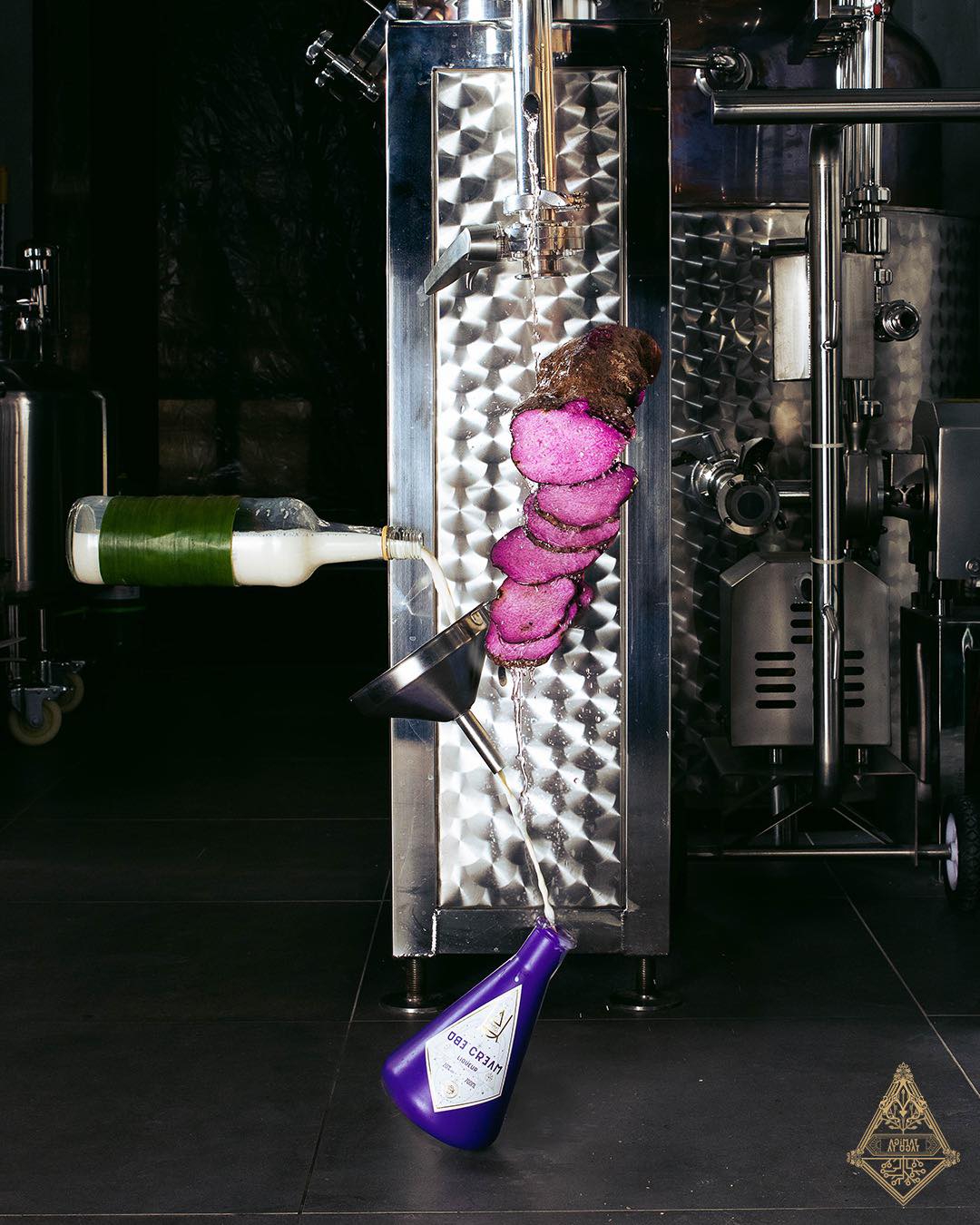
Photo source: https://www.facebook.com/agimatatugatbar/photos/
Can you imagine ube, a popular violet yam in the Philippines, used as an ingredient for an alcoholic beverage? You better believe it!
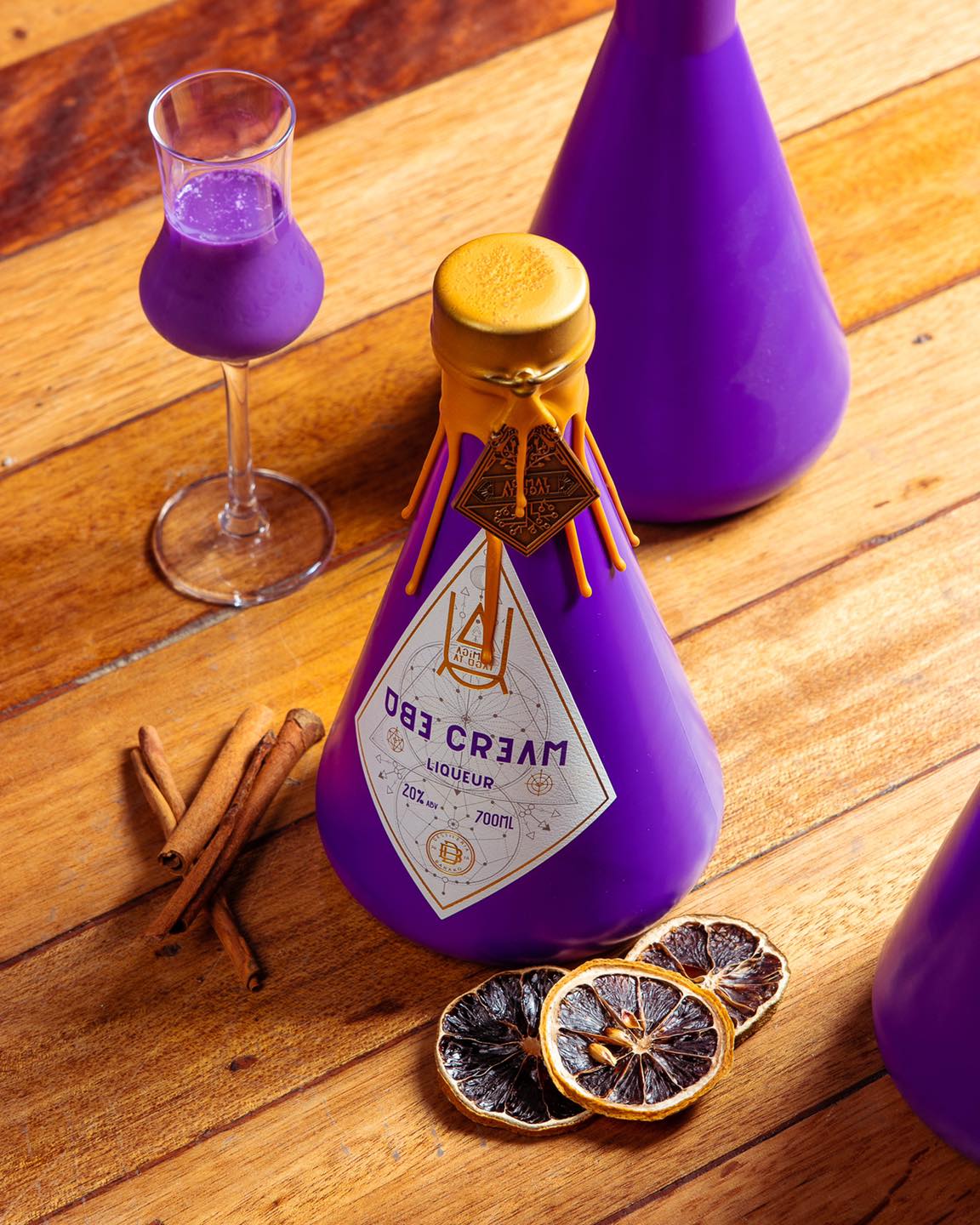
Photo source: https://www.facebook.com/agimatatugatbar/photos/1524722894530510
2. It was introduced on June 12, 2021, in time with the celebration of Philippine Independence Day.
3. It is made by Destileria Barako Corporation which is located on a 1,086 sq.m. piece of land in the municipality2 of Malay3, in the province4 of Aklan5, in the Western Visayas6 region7, in the central part of the Philippine archipelago. Its address is Lot 501B Naasug Road, Naasug, Malay, Aklan.
It was founded in 2016 by distiller Brendan Green. He later partnered with Tyson Branz and Kalel Demetrio. They initially made two award-winning spirits: Sirena Gin and Kanto Vodka. See Fact 9.
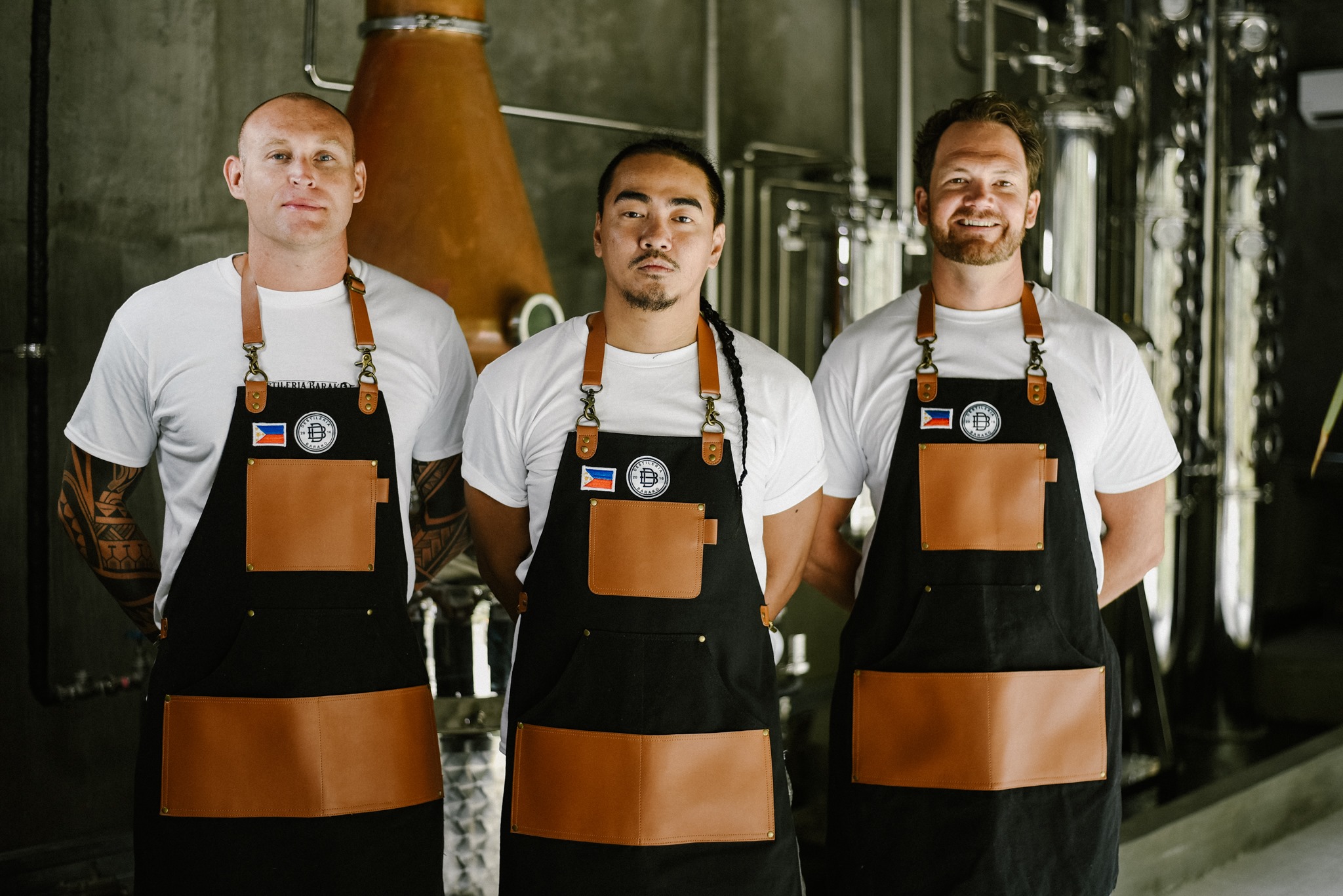
Photo source: https://www.facebook.com/agimatatugatbar/photos/1390639441272190
Kalel Demetrio is known as a local modern-day albularyo8 who “specializes in Filipino indigenous ingredients to bring in the Filipino essence” in products he makes.
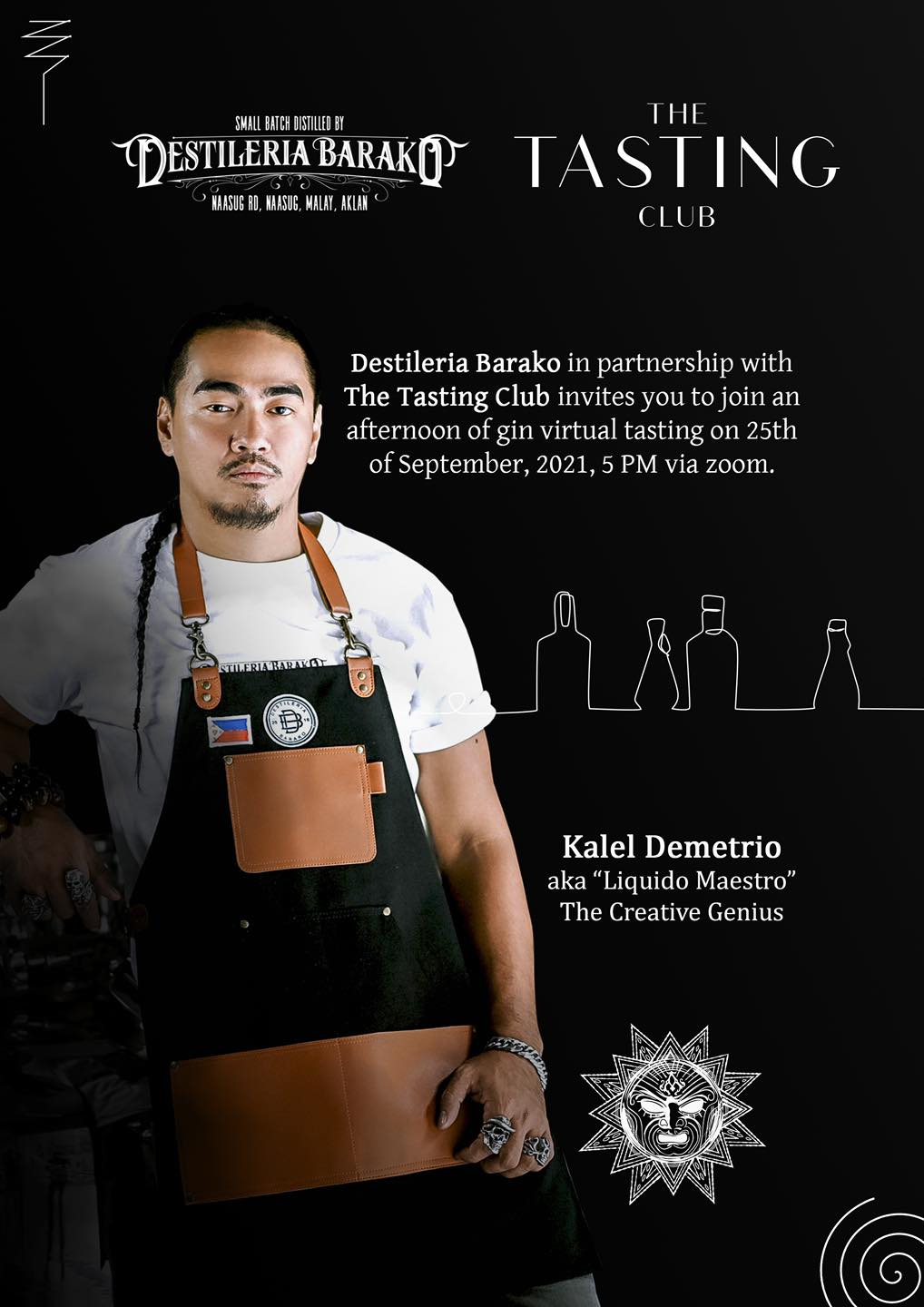
Photo source: https://www.facebook.com/agimatatugatbar/photos/
The company operates the main distillery in the resort island of Boracay9. Yes, it is the world famous resort island known for its powdery white sand beach, and then some!
The trio works closely with different farmers to highlight the best local produce in the Philippines. You will realize this in Fact 9 when you see the ingredients of the different products of this distillery. They distill their spirits from Negros sugar10.
Their current manufacturing capacity for distilled spirits is 12,000 liters, or 16,000 bottles per day, making Destileria Barako the leading boutique distillery in the Philippines.
You can visit the website: https://destileriabarako.com for free delivery within Metro Manila, and to request for tours in either their Aklan5 or Makati11 distillery.
4. It is sold in a matte purple Erlenmeyer flask-style bottle with mystical symbols. The bottle is sealed with bronze wax and comes with a metallic talisman that can be used as a fashion accessory.
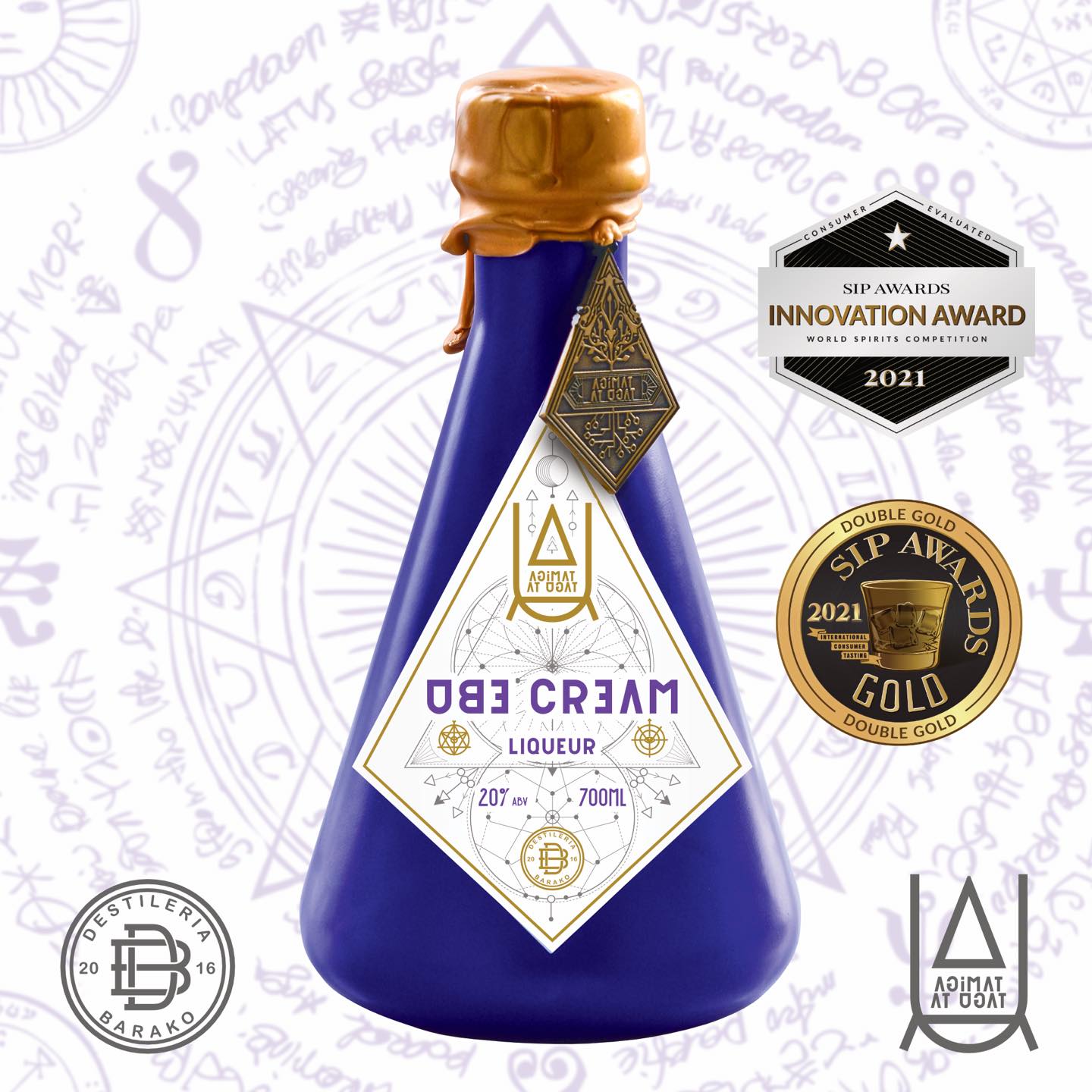
Photo source: https://www.facebook.com/agimatatugatbar/photos/a.630675923935216/1449562425379891/
And if you find time to go to Makati11 for a drink, why not accessorize with this talisman, and drop by Agimat at Ugat Foraging Bar, located in Poblacion, Makati, so you can get special perks. This bar features drinks using the spirits distilled by Destileria Barako.
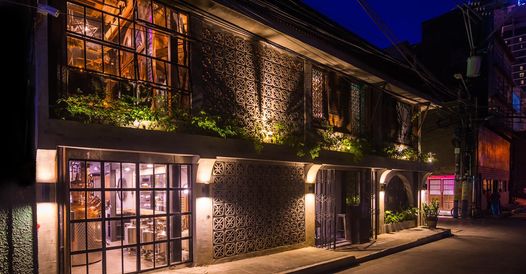
Photo source: https://www.facebook.com/agimatatugatbar/photos/a.583184592017683/1548333672169432
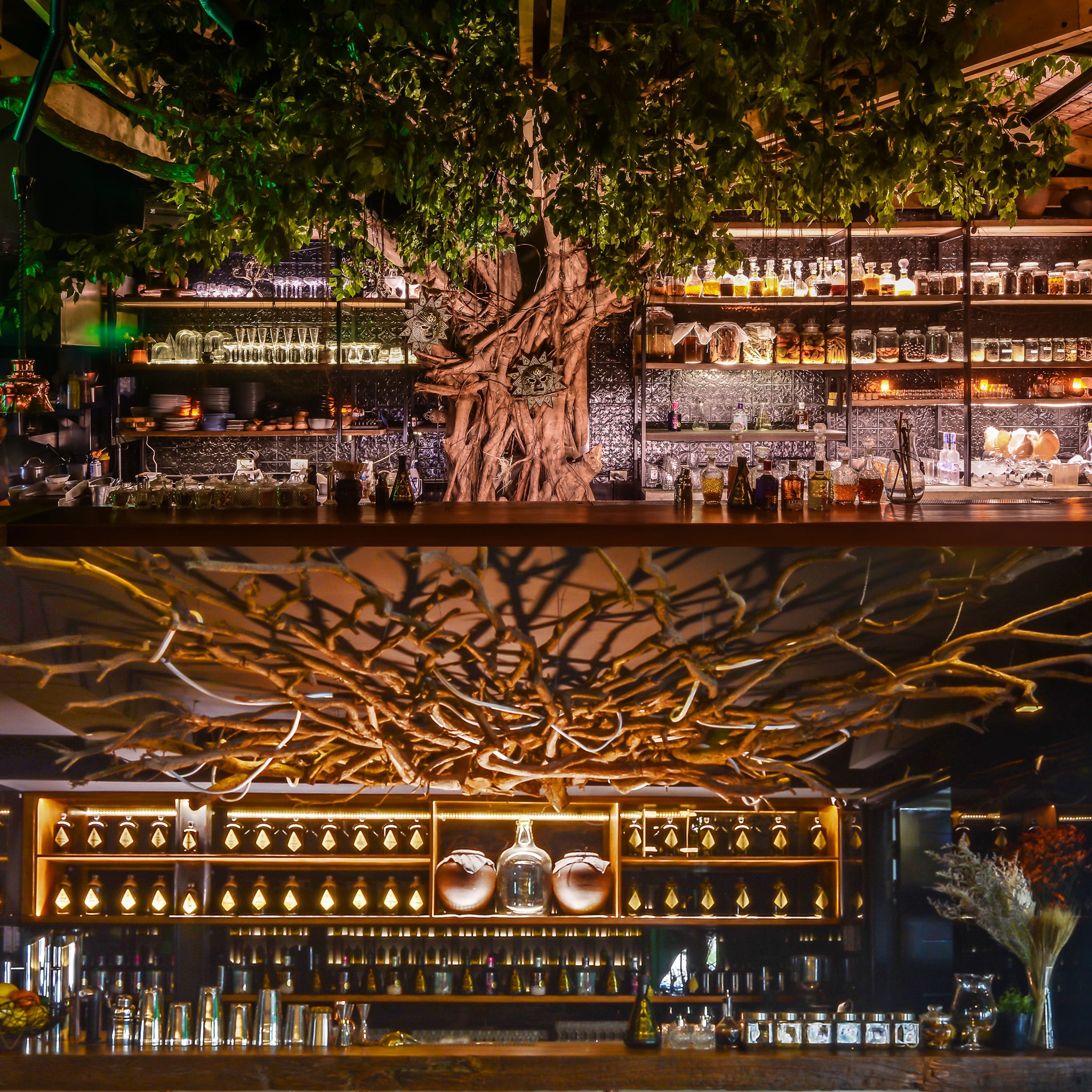
Photo source: https://www.facebook.com/agimatatugatbar/photos/a.583184592017683/1545813742421425
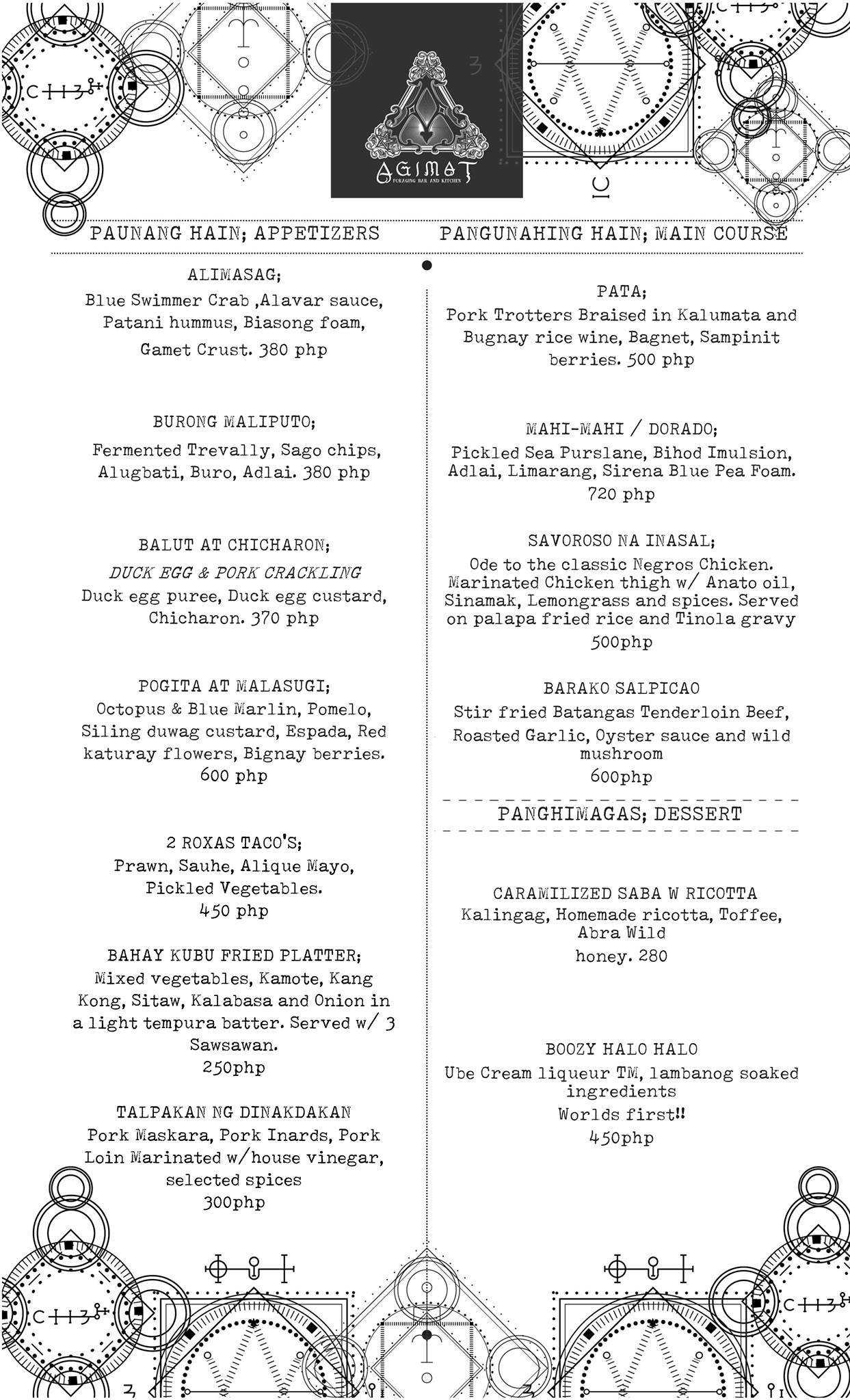
Photo source: https://www.facebook.com/agimatatugatbar/photos/p.1535224140147052/1535224140147052/?type=3&theater
5. Ube Cream Liqueur is best served chilled – neat or on the rocks. It is not too sweet, just the right sweetness!
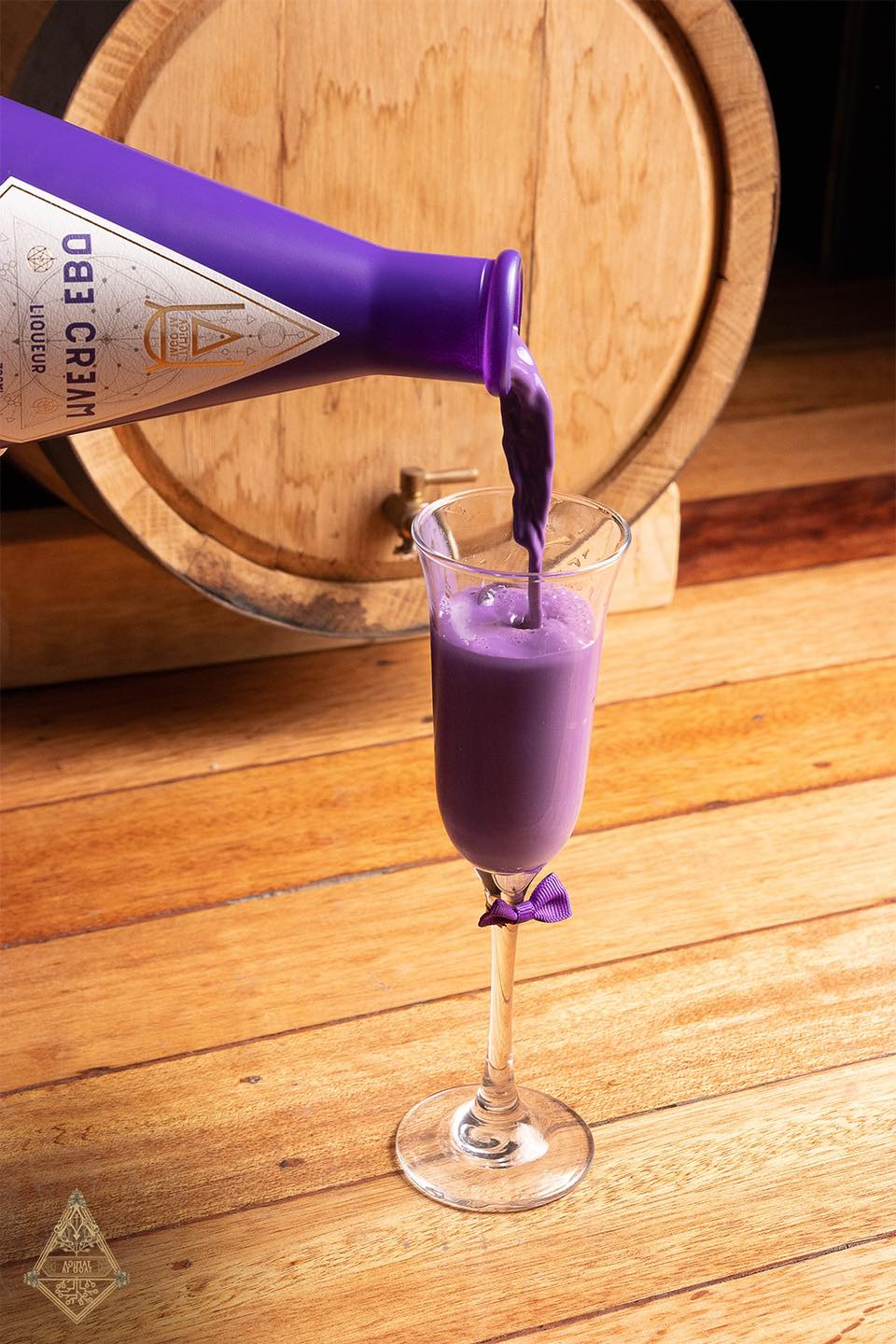
Photo source: https://www.facebook.com/agimatatugatbar/photos/
It could be layered on shooters or added in cocktails, It also makes an interesting, spiked halo-halo12 dessert, or as a topping for queso (cheese) or halo-halo ice cream.
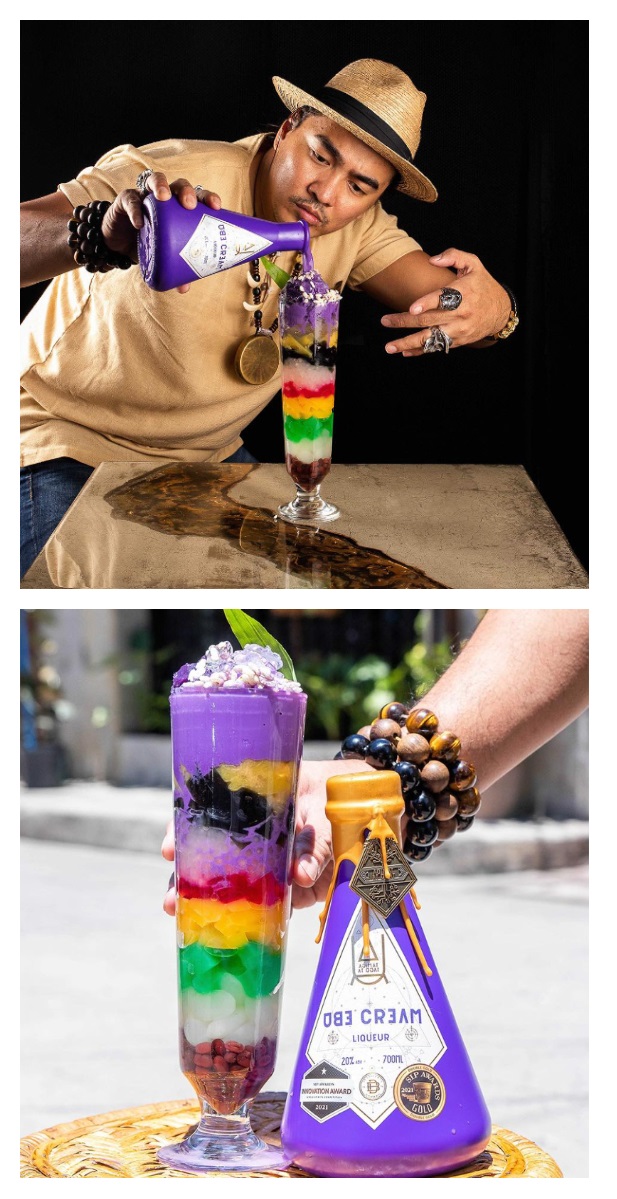
Source of photos: https://www.facebook.com/agimatatugatbar/photos/
MO Bar at the Mandarin Oriental, Singapore, recognized as one of Asia’s 50 Best Bars in 2021, showcased these 2 cocktails using Ube Cream Liqueur, October 11, 2021:
* UBEst I Ever Had – A cocktail made of Ube Cream Liqueur, bourbon and Malibu coconut rum, rimmed with powdered coconut.
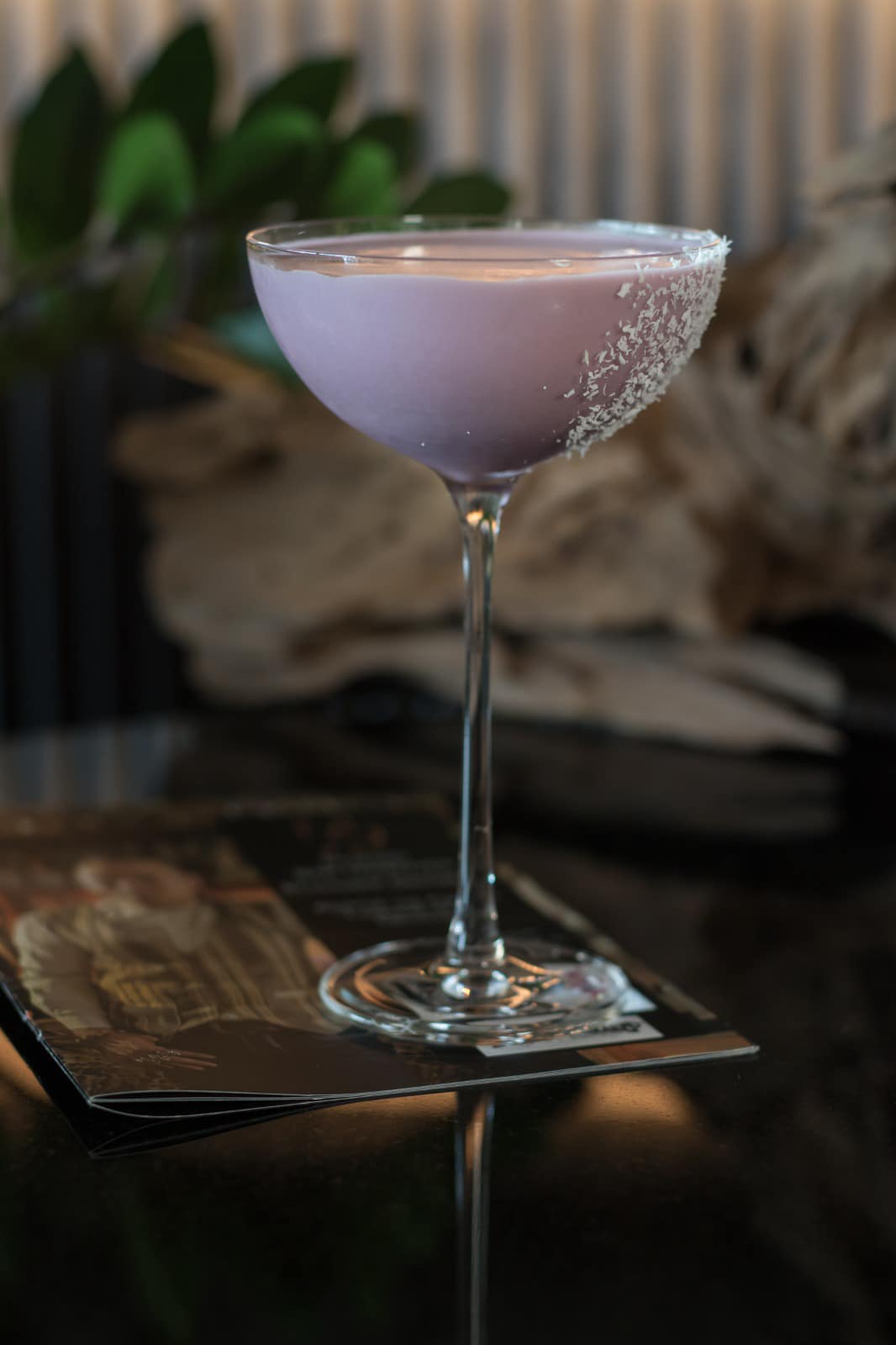
Photo source: https://www.facebook.com/agimatatugatbar/photos/pcb.1533035320365934/1533033150366151/
* UBE Cream Mudslide – A cocktail made of Ube Cream Liqueur, dark rum, coconut milk, a hint of muscovado13, topped with toasted Palawan14 cashew and toasted desiccated coconut.
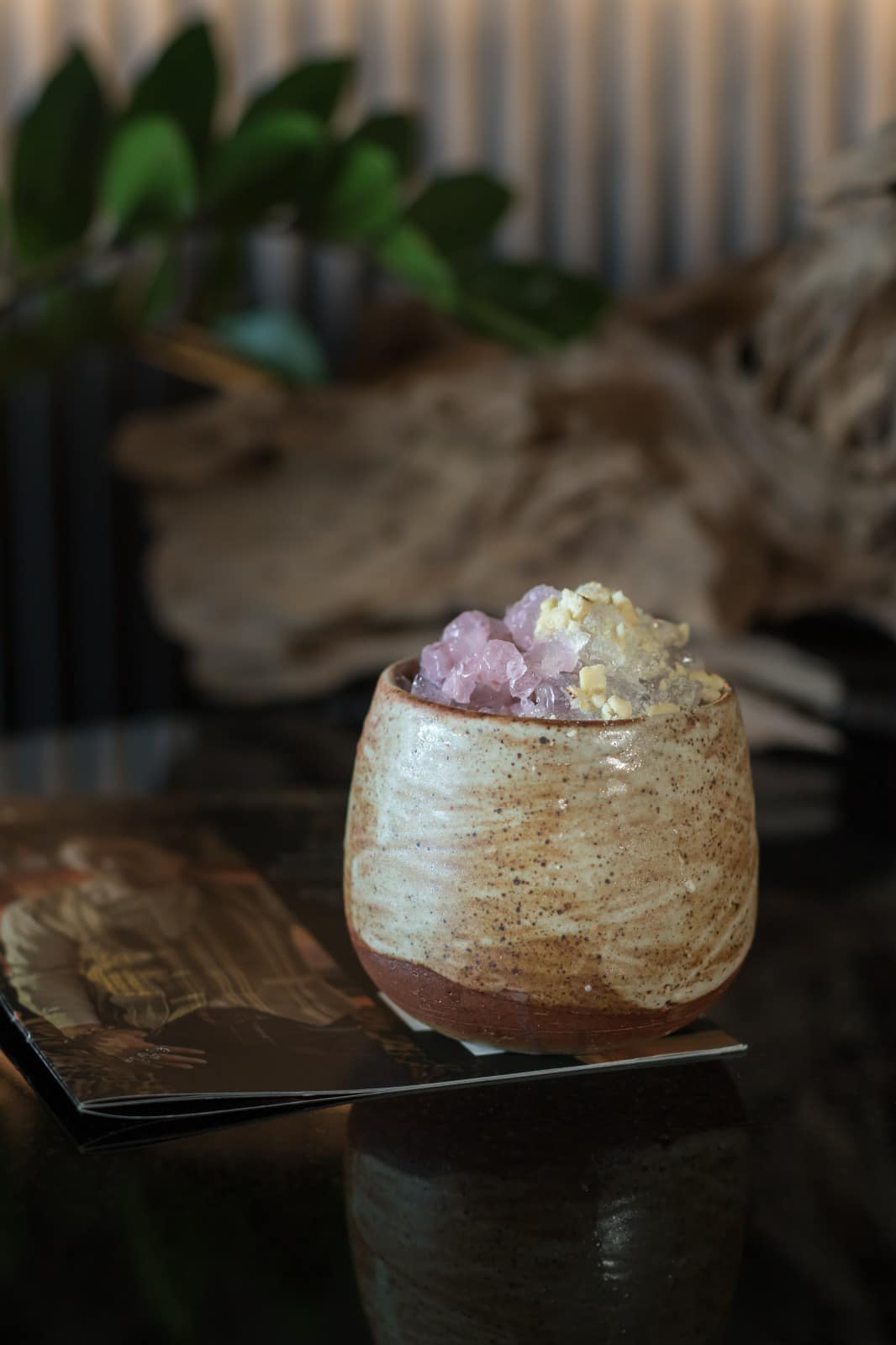
Photo source: https://www.facebook.com/agimatatugatbar/photos/1533033213699478
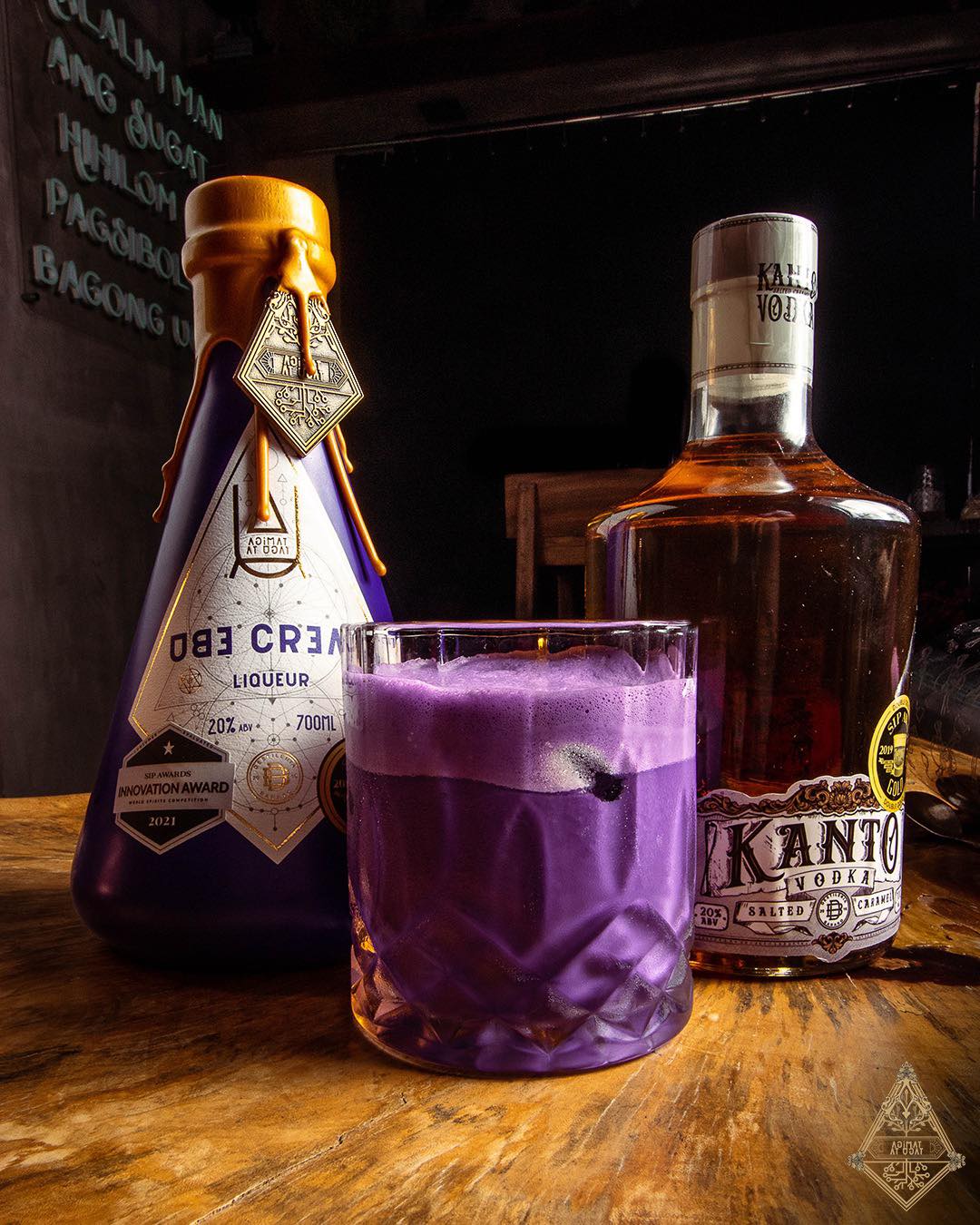
Try the cocktail called PagUBEg sa Kanto. It is the combination of 2 Destileria Barako products: Ube Cream Liqueur and Kanto Salted Caramel Vodka (see below). It has a creamy, nutty vanilla sweetness. – Photo source: https://www.facebook.com/agimatatugatbar/photos/1462994837369983
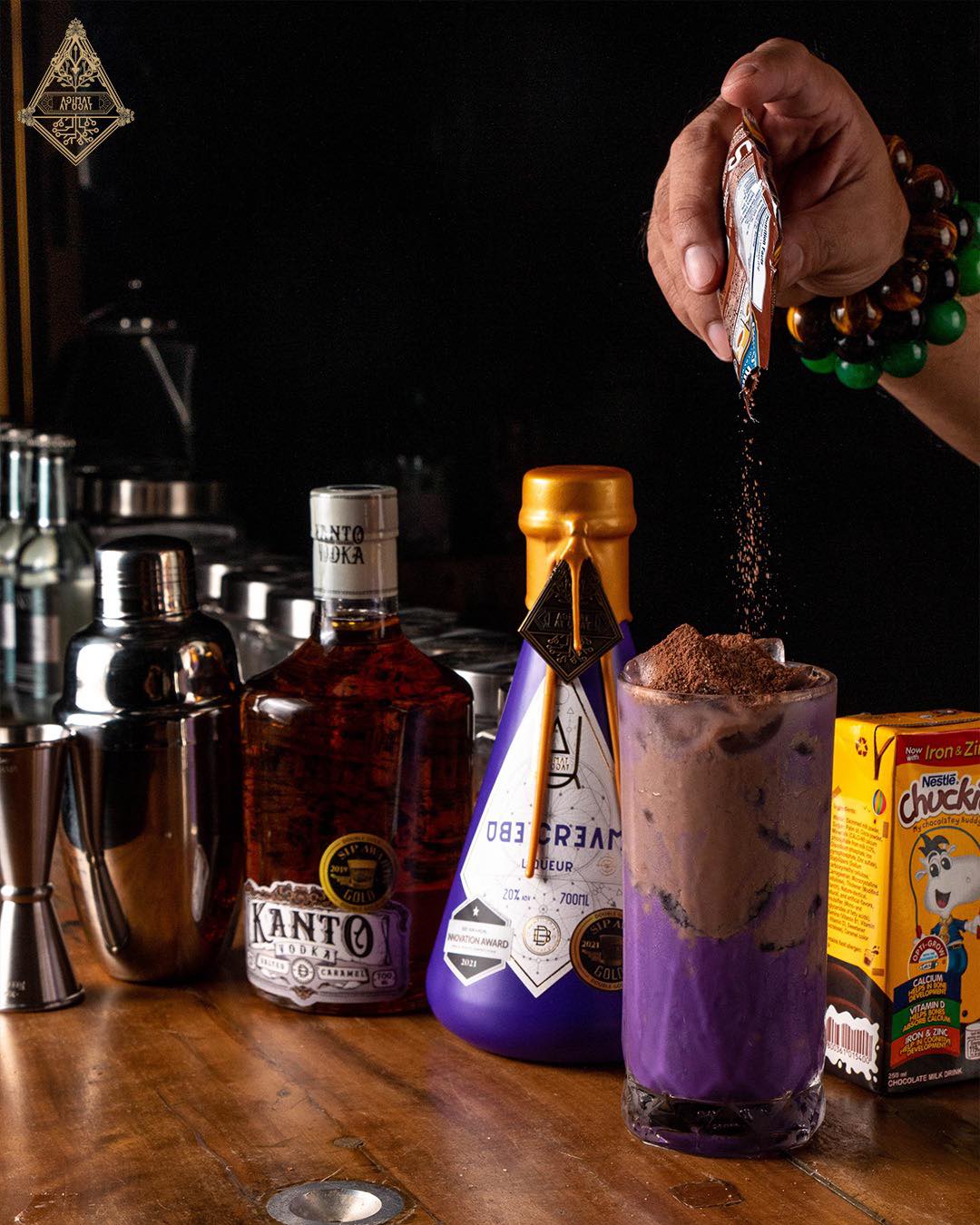
Try another concoction called Tsokolate at Ube. It also uses the 2 Destileria Barako products: Ube Cream Liqueur and Kanto Salted Caramel Vodka, but with the addition of chocolate milk and chocolate powder. See the recipe in Footnote 15. – Photo source: https://www.facebook.com/agimatatugatbar/photos/1550454025290730
6. A 700 ml bottle of Ube Cream Liqueur costs PHP1,200 (US$24).
7. You can:
* order at the Destileria Barako page – https://destileriabarako.com for free delivery within Metro Manila (minimum PHP1,200 order), or pick up at its distillery-bar called Agimat at Ugat Foraging Bar at 5972 Alfonso Street corner Fermina Street, Poblacion, Makati City.
* order online through its retail partners:
Boozy.ph (PHP1,199) – http://bit.ly/3hOcbzd
Lazada (PHP1,200) – http://bit.ly/
Liquor.ph (PHP1,579) – http://bit.ly/3pGA3qC
It is also sold in GrabMart, Lazada, and The PCK.
* buy from any of the following: Coles, Crimson Resort and Spa Boracay, Duty Free Philippines, Landers Superstore, Landmark, Marketplace (by Rustan’s), Ralph’s Wines & Spirits, Robinson’s Supermarket, Rustan’s Supermarket, and Shopwise.
8. It won:
* Spirits International Prestige (SIP) Awards’ 2021 Double Gold
* SIP Awards 2021 Innovation Award – the Philippines’ first product innovation award at the SIP Awards in California.
Note that SIP Awards is recognized as the largest consumer judged spirit awards in the world.
9. FYI – Destileria Barako also produces the following alcoholic beverages:
* Agimat Gin (PHP1,700 for a 700 ml bottle; US$34) – This 43%-abv gin uses spices, floral and citrus ingredients like ylang-ylang (a very fragrant flower), dalandan (a citrus fruit from Luzon16), biasong (a wild citrus fruit in southern Philippines), libas fruit (a popular souring ingredient from the Visayas17), pink pomelo (a citrus fruit from Mindanao18), yutukon (a kind of ginger), and other international ingredients. It was awarded the SIP 2021 Silver Award.
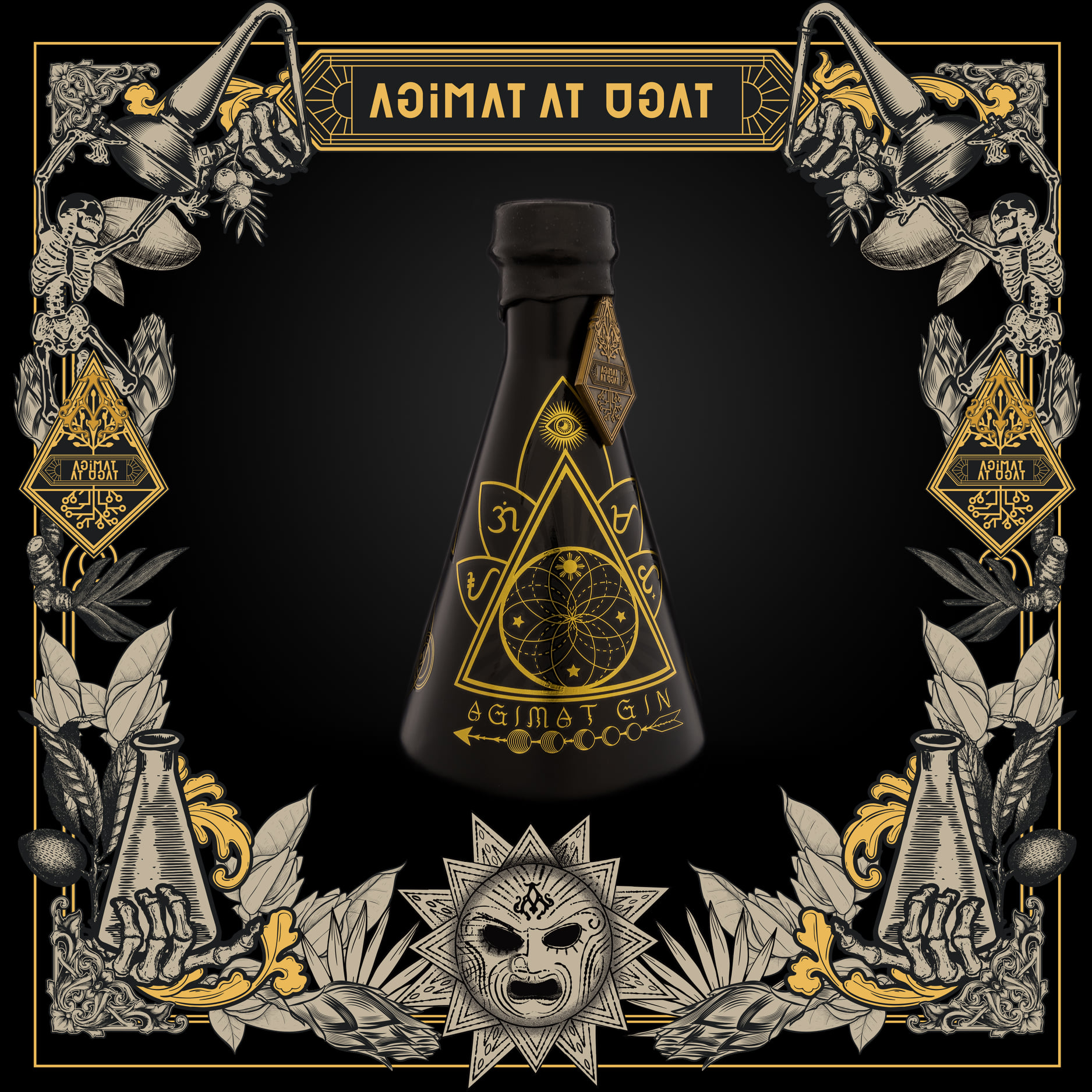
Photo source: https://www.facebook.com/agimatatugatbar/photos/a.585914045078071/1381136782222456
* Agimat at Ugat Vodka (PHP800 for a 700 ml bottle; US$16) – This is a triple distilled, 40%-abv craft vodka made from fresh Negros sugar cane10. The mixture runs along 4 filtration passes through charcoal made from Mindoro19 coconut husk for its sought-after smoothness.
* Bacon Vodka (PHP1,300 for a 700 ml bottle; US$26) – This 40%-abv hand-crafted and small-batch vodka is made from fresh Negros sugar cane10 infused with smoked bacon and smoke seasoning for 48 hours to allow the flavor molecules to blend. Vacuum distillation is used to extract the flavors. This vodka is perfect for Bloody Mary and other savory cocktails. It is dubbed as Asia’s first bacon-infused premium vodka.
* Gayuma Liqueur (PHP900 for a 700 ml bottle; US$18) – This is a 20%-abv vodka-based liqueur flavored with lemon grass and lychee. It was awarded the SIP 2021 Gold Award.
* Kanto Perya Popcorn Vodka (PHP900 for a 700 ml bottle; US$18) – This 20%-abv vodka is made from Negros sugar cane10 infused with popcorn party favor. It got the SIP 2021 Silver Award.
* Kanto Salted Caramel Vodka (PHP900 for a 700 ml bottle; US$18) – This 20%-abv vodka is made from sugarcane, muscovado13 caramel and sea salt, all from Negros20.
* Sirena Blue Pea Gin (PHP1,000 for a 700 ml bottle; US$20) – This 43%-abv, new-age style, small-batch gin is distilled with 14 locally- and internationally-sourced botanicals, including the Philippine sampaguita (a jasmine-type of flower; the national flower of the Philippines), pink pomelo (a citrus fruit from Mindanao18) and blue pea flower21, for floral and citrus bursts. It was given the SIP 2019 Consumers’ Choice Award and the SIP 2018 Double Gold Award.
* Sirena Dry Gin (PHP1,000 for a 700 ml bottle; US$20) – This 43%-abv dry gin is distilled with 11 locally- and internationally-sourced botanicals like Philippine sampaguita, pink pomelo and rambutan22. It was given the SIP 2019 Platinum Award in the gin category.
Destileria Barako is the first distillery in the world to vapor-infuse rambutan for this gin to have a delicate scent and a delicious, fruity mouthfeel.
10. Here are the contact details of Destileria Barako:
Telephone number: (02) 8696 2208
Cell number: 0995-2943231
Facebook: https://www.facebook.com/agimatatugatbar/
Email: sales@destileriabarako.com
The information was obtained from https://destileriabarako.com, https://www.facebook.com/agimatatugatbar/photos/1487034651632668, https://news.abs-cbn.com/life/06/22/21/like-ube-kalel-demetrio-has-made-a-cream-liqueur-thats-proudly-pinoy, https://www.wheninmanila.com/ube-cream-liqueur-exists-and-our-cocktails-are-ready/, https://www.spot.ph/eatdrink/the-latest-eat-drink/86483/destileria-barako-ube-cream-liqueur-a3284-20210615 and https://www.pressreader.com/philippines/philippine-daily-inquirer-1109/20210701/282243783573524.
The photos featured in the cover photo-collage were obtained from: https://www.facebook.com/agimatatugatbar/photos/
Well, have I convinced you to try and experience Ube Cream Liqueur? If you do, tell Tita S about it. Filipinos, be proud of, and buy, local products!
I will order online and update this post.
This is not a sponsored post. I just want my readers to know more about Philippine beverages.
Did you find this post informative? I would like to hear your comment/s regarding Ube Cream Liqueur.
See other interesting posts in this category (Pinoy Delights) and other categories – SCapades and Smart Travelers – Foreign Travelers Ask, Now You Know, and Say, Say, Say. Happy reading, and I hope that you will appreciate what I shared and some of the featured destinations will be part of your future travel plans!
Remember to share this post with your Facebook friends, and follow me by clicking on the bottom right corner of your device. And, do not forget to like this post. Thank you.
– – – – – – – – – – – – – – – – – – – – – – – – – –
The following terms are defined for interested readers, especially those with “Senior-Moments”, those not familiar with Filipino terms, and those too busy or lazy to Google such terms:
1Dioscorea alata, also known as ube, purple yam, greater yam, among many other names, is a species of edible yam or tuber, usually with a vivid violet-purple to bright lavender color because of a high amount of anthocyanins, but some range in color from cream to plain white. It has a mildly sweet, earthy and nutty taste, reminiscent of taro or sweet potatoes.
It originated from Asia but is also grown in Okinawa, tropical South America, Africa, Australia and southeastern USA so other common names include Guyana arrowroot, ten-months yam, violet yam, water yam, and white yam.
Would you believe that remains of ube have been recovered from the Ille Cave archaeological site of Dewil Valley, in New Ibajay, in the municipality2 of El Nido, in the northernmost part of Palawan14, c. 11,000 BP?
Ube is widely used as a flavoring for Filipino ice cream, jam, cake, tarts, milk, pastries and a variety of desserts like ube halaya23 and halo-halo12.
The information was obtained from the Wikipedia page “Dioscorea alata”.24
2A municipality is a small, single urban administrative division in the Philippines which has corporate status and powers of self-government or jurisdiction as granted by law. It is a unit under a province4, subdivided into barangays25, and is locally called bayan. In the Philippines, a municipality is headed by a mayor, a vice mayor, and members of the Sangguniang Bayan (legislative branch). It can enact local policies and laws, enforce them, and govern its jurisdictions. It can enter into contracts and other transactions through its elected and appointed officials and can tax as well. It enforces all local and national laws. There are almost 1,500 municipalities in the Philippines. The information was obtained from Wikipedia page “Municipalities of the Philippines.”26
3Malay is a first class27 municipality2 in the province4 of Aklan5, in the Western Visayas6 region7 of the Philippines. It is the northernmost town in the island of Panay28, the youngest among all municipalities in the province, and as of 2020, it is the second most populated municipality in Aklan.
It has a total land area of 66.01 sq.km. (25.49 sq.mi.), with 17 barangays25. The resort island of Boracay9 is part of this municipality. It is the richest municipality in the province in terms of income and annual budget due to tourism.
The information was obtained from Wikipedia page “Malay, Aklan.”29
4A province is the primary administrative and political division in the Philippines. It is the second-level administrative sub-division of a region7. There are 81 provinces (called lalawigan) in the Philippines. Each province is governed by an elected legislature called the Sangguniang Panlalawigan, and by an elected governor. Remember, a province in the Philippines is divided into cities and municipalities2 (or towns), which in turn, are divided into barangays25, formerly called barrios. The information was obtained from Wikipedia page “Provinces of the Philippines.”30
See a related post: Foreign Seniors Ask: WHAT ARE PROVINCES IN THE PHILIPPINES?
5Aklan is a province4 in the Western Visayas6 region7 of the Philippines which occupies the northern third of the Panay Isand28 in the northwestern portion, facing the Sibuyan Sea and the province of Romblon to the north, and bordering Antique to the southwest and Capiz to the east. It has 17 municipalities4 and its capital is Kalibo5.
It is called the oldest province in the Philippines because it was organized in 1213 by settlers from Borneo, along with the province of Capiz. It was inaugurated as an independent province on November 8, 1956.
Aklan is famous for Boracay9, a resort island 1 km (0.62 mi) north from the tip of Panay26.
The information was obtained from https://ph.news.yahoo.com/aklan-philippines-oldest-province-061046849.html and the Wikipedia page “Aklan.”31
6Western Visayas is an administrative region7 in the Philippines, also known as Region VI, with a land area of 20,794.18 sq.km. (8,028.68 sq.mi.). It consists of 6 provinces4 (Aklan5, Antique, Capiz, Guimaras, Iloilo and Negros Occidental), 2 highly urbanized cities32 (Bacolod City and Iloilo City), 14 component cities33, 117 municipalities2, and 4,051 barangays25. It is considered the most populous region in the Visayas17 group of islands in the central part of the Philippine archipelago. The information was obtained from the Wikipedia page “Western Visayas”.34
7A region is an administrative division based on geographical, cultural and ethnological characteristics. Each region is further subdivided in provinces4, composed of cities and municipalities2 (or towns), which in turn, are divided into barangays25, formerly called barrios, according to Wikipedia page “Regions of the Philippines” 35.
See a related post: Foreign Seniors Ask: WHAT ARE THE REGIONS OF THE PHILIPPINES?
8An albularyo is the Filipino term for a witch doctor, folk healer, or medicine man who practices folk medicine and uses traditional practices like hilot (massage) and the use of medicinal plants (leaves, barks, roots, oils) to heal people, commonly found in rural areas of the Philippines. Believers claim that the albularyo has supernatural powers or even practices black magic, uses prayers called orasyon and rituals to drive away spirits to remove the sickness of patients, and he/she is considered as the first or the last resort for their illnesses. The information was obtained from the Wikipedia page “Albularyo”.36
9Boracay is a small island at the northwestern tip of Panay Island28, in the Western Visayas6 region7 of the Philippines. It is administered by the Tourism Infrastructure and Enterprise Zone Authority (TIEZA) and the provincial government of Aklan5. It is known the world over for its fine white sand beaches, and was repeatedly chosen and awarded as one of the top destinations in the world for relaxation. The information was obtained from Wikipedia page “Boracay.”37
10As of 2005, the Philippines was the 9th sugar producer in the world, the 2nd largest sugar producer among ASEAN countries, after Thailand, according to the Food and Agriculture Organization.
At least 17 provinces4 of the Philippines grow sugarcane, of which 2 on Negros Island20 account for half of the country’s total production. As of 2010, there were 29 sugar mills, 13 of which are in Negros Island, 6 in Luzon16, 4 in Panay28, 3 in Eastern Visayas38 and 3 in Mindanao18. The harvest period is from October to December and ends in May.
The information was obtained from Wikipedia page “Sugar industry of the Philippines.”39
11Makati is a first class27 highly urbanized city32 in the National Capital Region (NCR)40 in the Luzon16 group of islands of the Philippines. It is called the Financial Capital of the Philippines since it has the highest concentration of multinational and local corporations in the country. Major banks, corporations, hotels, department stores and foreign embassies are also based in this city. It is also known for being a major cultural and entertainment hub in the region.
Would you believe that its population is only half a million in its total area of 21.57 sq.km. (8.33 sq.mi.) but there are more than a million people during a typical working day because of the large number who work, shop and do business there?
Makati was founded on November 4, 1670, and became a city on February 4, 1995. It has 33 barangays25. Visit its website: www.makati.gov.ph
The information was obtained from Wikipedia page “Makati.”41
12Halo-halo, or haluhalo, is a popular cold dessert or snack in the Philippines made of crushed ice, evaporated milk or condensed milk, and various ingredients like different kinds of sweetened beans, ube (purple yam)1, coconut strips, gulaman (agar), sago (tapioca pearls), pinipig (toasted, pounded immature grains of glutinous rice), topped with leche flan (Philippine creme caramel). Other ingredients used are fruit slices, sweetened langka (jackfruit), boiled and cubed taro, and soft cubed yams. For a special treat, a scoop of ice cream, preferably ube, tops this dessert. The information was obtained from the Wikipedia page “Halo-halo”.42
13Muscovado is a very dark brown, partially refined sugar with a strong molasses content and flavor. It takes its flavor and color from sugarcane juice where it came from. It offers good resistance to high temperatures and has a reasonably long shelf life. It is slightly coarser and stickier than most brown sugars so it can be substituted for the latter in most recipes by slightly reducing the liquid content of the recipe.
It is considered a healthy alternative to refined sugar due to higher levels of minerals (calcium, iron, magnesium, phosphorus and potassium).43
The largest producer and consumer of muscovado is India.
It is used as an ingredient in food and confectionery, and as a sweetener in hot beverages. It is often used to sweeten coffee.
The information was obtained from the Wikipedia page “Muscovado”.44
14Palawan is an archipelagic province4 in the Philippines located in the Mimaropa45 Region7 of the Philippines, founded in 1818, and the largest province in the country in terms of total area of jurisdiction. It has a total land area of 14,649.73 km2 (5,656.29 sq.mi.). Its capital is Puerto Princesa, a highly urbanized city32 governed independently from the province.
This province is named after its largest island, Palawan Island. The islands of Palawan stretch between Mindoro19 in the northeast and Borneo in the southwest. It lies between the South China Sea and the Sulu Sea.
Conservation International describes Palawan as “the Philippines’ Last Biodiversity Frontier” because it still retains more than 50% of its original forest cover and harbors vast stretches of old growth forests on its mountainous slopes.
Do you know that cashew is the 3rd most important nut in world, after almond and hazelnut? Now, how about Palawan cashew? Well, here is another fact: the cashew (kasuy in Tagalog) sold in many parts of the Philippines are grown and produced in Palawan, considered the Cashew Capital of the Philippines since 24,345 hectares are planted with 3.1 million cashew trees in 20 municipalities (with El Nido, Dumaran and Roxas as the top 3 producers), and account for 90% of the country’s annual total cashew production, or 116,900 tons!
The information was obtained from https://businessmirror.com.ph/2016/07/06/palawan-phls-last-frontier-under-siege/#:~:text=Conservation%20International%20describes%20it%20as,forests%20on%20its%20mountainous%20slopes, https://mindoropost.wordpress.com/2011/01/07/palawan-is-countrys-cashew-capital/ and the Wikipedia page “Palawan”46.
15TSOKOLATE AT UBE
45 ml Kanto Salted Caramel Vodka
60 ml Ube Cream Liqueur
60 ml chocolate milk (e.g., Chuckie)
Chocolate powder (e.g., Swiss Miss)
Using a highball glass, build with liqueur, vodka, chocolate milk and crushed ice.
Sprinkle top with chocolate powder.
This recipe was obtained from https://www.facebook.com/agimatatugatbar/photos/1550454025290730.
16Luzon is the largest and most populous island in the Philippines. It is ranked the 15th largest island in the world by land area, at 109,964.9 sq.km. (42,457.7 sq mi). It is the northern portion, among the three primary island groups in the Philippine archipelago, with Visayas17 at the center, and Mindanao18 at the southern part. It is the economic and political center of the country, with Manila as the capital city, and Quezon City as the country’s most populous city. It has a population of 53 million, as of 2015, representing 52.5% of the country’s total population, and the fourth most populous island in the world. The name Luzon comes from the Tagalog word lusong, a large wooden mortar used to de-husk rice. The information was obtained from the Wikipedia page “Luzon” .47
17Visayas is one of the 3 major geographical divisions of the Philippines. It covers 3 administrative regions: Central Visayas, Eastern Visayas37 and Western Visayas6. It consists of 6 major islands (Bohol, Cebu, Leyte, Negros20, Panay28 and Samar) mostly surrounded by the Visayan Sea, and is composed of 16 provinces4, according to Wikipedia page “Visayas”.48 The 2 other geographical divisions of the Philippines are Luzon16 (the northern part) and Mindanao18 (the southern part).
18Mindanao, commonly known as Southern Philippines, is one of the 3 major geographical divisions of the Philippines, located at the southernmost part of the country. It is the second largest island of the country and covers 6 administrative regions7: Bangsamoro Autonomous Region in Muslim Mindanao (BARMM), CARAGA Region, Davao Region, Northern Mindanao, Soccsksargen (South Cotabato, Cotabato, Sultan Kudarat, Sarangani and General Santos), and Zamboanga Peninsula. It is composed of 22 provinces4 and 33 cities. The information was obtained from the Wikipedia page “Mindanao.”49 The 2 other major geographical divisions of the Philippines are Luzon16 (in the northern part) and Visayas17 (in the central part of the country).
19Mindoro is the 7th largest and 8th most populous island in the Philippines. It is located off the southwestern coast of Luzon16 and northeast of Palawan14. Its southern coast forms the northeastern extremum of the Sulu Sea. It has a total land area of 10,571 sq.km. (4,082 sq.mi.). It is divided into 2 provinces4: Occidental Mindoro and Oriental Mindoro. Mount Halcon is the highest point, at 2,586 m (8,484 ft) above sea level, located in Oriental Mindoro.
Its economy is largest based on agriculture: fruits (citrus, bananas, lanzones, rambutan, coconut), rice, corn, sugarcane, peanuts, fish (catfish, milkfish, tilapia), livestock and poultry. Tourism is lucrative with Puerto Galera (as the most popular tourist attraction), Apo Reef National Park, Luban Island, Sabang Beach and Mount Halcon.
There is also logging and mining (copper and marble).
Do you know that Mindoro is the home of the tamaraw or Mindoro dwarf buffalo (Bubalus mindorensis), which is endemic to the island? It is related to the water buffalo (carabao) but is considered an endangered species. I hope the local government is doing something to save this species.
The information was obtained from the Wikipedia page “Mindoro” .50
20Negros is the fourth largest island in the Philippines, the second largest in the Visayas17 (after Samar), with a total land area of 13,309.6 sq.km. (5,138.9 sq.mi.), inhabited mainly by Negrenses, locally called Negrosanons. It is located between the islands of Panay28 and Guimaras to the west, Cebu to the east, Bantayan Islands to the north, and Siquijor to the south. It is divided into 2 provinces4: Negros Occidental (Ilonggo-speaking) and Negros Oriental (Cebuano-speaking). The information was obtained from the Wikipedia page “Negros”.51
21Clitoria ternatea flower, commonly known as Asian pigeonwings, bluebellvine, blue pea, butterfly pea, cordofan pea and Darwin pea, is the flower of a plant species with the same name, belonging to the family Fabaceae. This solitary 4 cm. (1.6 in.) long by 3 cm. (1.2 in.) wide flower has a vivid deep blue color with light yellow markings.
This plant is native to equatorial Asia, including South Asia and Southeast Asia, but was also introduced to Africa, the Americas and Australia. The Latin name of the genus Clitoria was given since the flower has the shape of the human female genitals, and ternatea comes from the Indonesian city Ternate where this species originated. This flower is used as a natural food coloring to color glutinous rice and desserts in Southeast Asia. If you are not familiar with this flower, here is a photo:
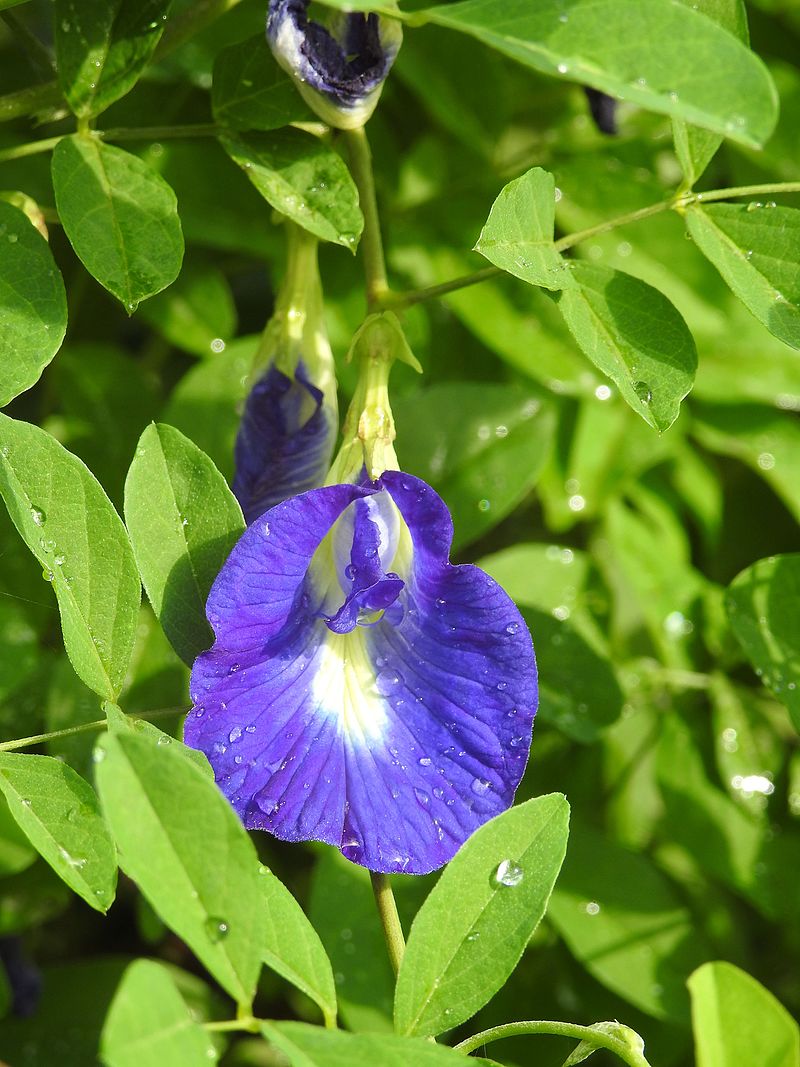
Photo source: Dr. Raju Kasambe, own work, CC BY-SA 3.0, created 21 August 2016, https://en.wikipedia.org/wiki/Clitoria_ternatea#/media/File:Clitoria_ternatea_flower_by_Dr._Raju_Kasambe_DSCN1517_(8).jpg
Butterfly pea flower tea, made from this flower and dried lemongrass, can be served hot or cold. It changes color depending on what is added to the liquid, like with lemon juice it turns purple, or with honey and lemon, it turns pink-purple in color.
It turns gin from colorless to blue, but turns to pink when a carbonated mixer like tonic water is added due to the change in pH.
The information was obtained from the Wikipedia page “Clitoria ternatea”.52
22Rambutan is the name of the medium-sized tropical tree in the family Sapindaceae native to Southeast Asia and its edible, hairy fruit. It is closely related to lychee, longan, pulasan and mamoncillo.
The name rambutan is derived from the Malay word rambut meaning “hair”, referring to the profuse hairy protuberances of the fruit, together with the noun-building suffix, -an.
The leathery skin is reddish (rarely orange or yellow) and covered with fleshy pliable spines. The latter contribute to the transpiration of the fruit, which can affect the fruit’s quality.
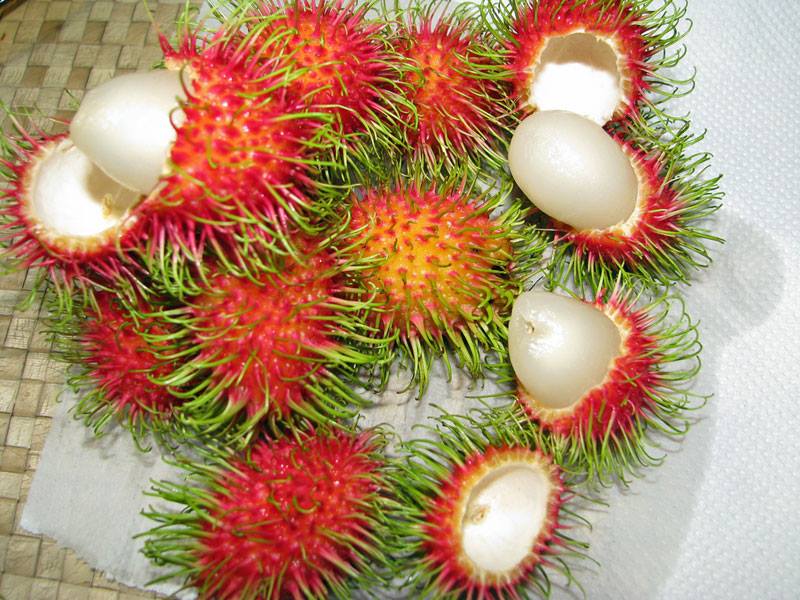
Photo source: https://www.facebook.com/Rambutan-870741392951962/photos/870757126283722
The fruit is a round to oval single-seeded drupe, 3-6 cm (rarely to 8 cm) long and 3-4 cm wide, borne on a loose pendant cluster of 10-20 together. The flesh, called aril, is translucent, whitish or very pale pink, with a sweet, mildly acidic flavor reminiscent of grapes. The flesh can be eaten raw or cooked. Tita S personally prefers this fruit refrigerated so she can eat it well chilled.
The single seed is glossy brown, 1-1.3 cm., with a white basal scar. It is soft and contains equal portions of saturated and unsaturated fats, so it can be cooked and eaten.
The information was obtained from the Wikipedia page “Rambutan”.53
23 Ube halaya, or halayang ube, is a Philippine dessert made from boiled and mashed purple yam (ube), sweetened coconut milk or condensed milk, melted butter or margarine, cooked till thickened. It is placed on a platter or a desired shaped container. It is typically served cold, after refrigeration. It can be topped with brown grated coconut, latik54, or condensed milk.
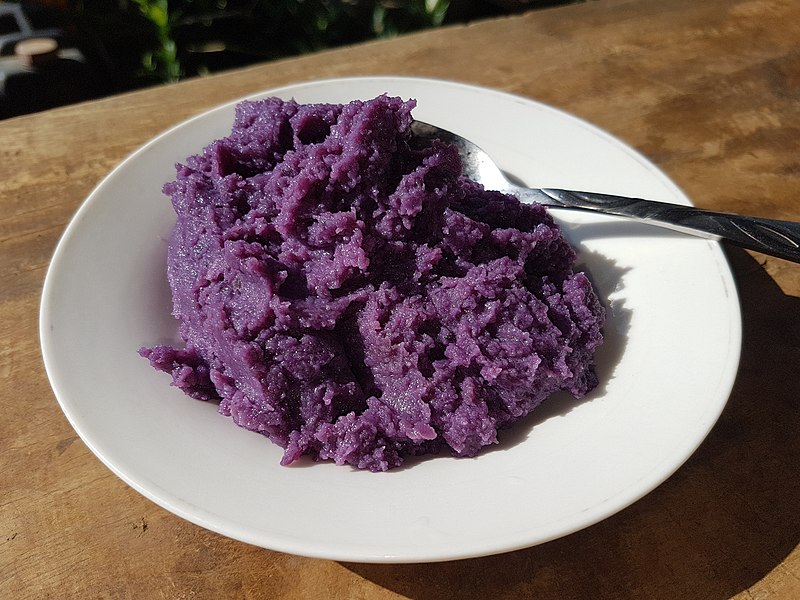
Photo source: Onsidian Soul, own work, CC0, created 18 May 2019, https://en.wikipedia.org/wiki/Ube_halaya#/media/File:Ube_halaya_-_mashed_purple_yam_(Philippines)_01.jpg
It is the main base in ube-flavored pastries and ice cream. It can also be incorporated in other desserts like halo-halo12. It is also commonly anglicized as ube jam, or called by its original native name, nilupak na ube.
The information was obtained from the Wikipedia page “Ube halaya”.55
24“Dioscorea alata,” accessed November 10, 2021, https://en.wikipedia.org/wiki/Dioscorea_alata
25A barangay in the Philippines is the smallest administrative division in the Philippines, headed by a barangay captain, aided by a Sangguniang Barangay (Barangay Council). It is the native Filipino term for a village. It was formerly called a barrio. In a metropolitan area, a barangay is an inner city neighborhood, a suburb, or a suburban neighborhood. The word barangay originated from the term balangay, a kind of boat used by a group of Austronesian people who migrated to the Philippines. A number of barangays grouped together is called a district. The information was obtained from Wikipedia page “Barangay”56.
26“Municipalities of the Philippines,” accessed May 29, 2019, https://en.wikipedia.org/wiki/Municipalities_of_the-Philippines
27A first class municipality in the Philippines is a town with an average annual income of at least PHP500,000, based on the previous four calendar years, according to the Wikipedia page “Cities of the Philippines”.57
28Panay Island is the 6th largest, and 4th most populous, island in the Philippines, located in the Western Visayas6 Region7 of the Philippines, with a total land area of 12,011 sq.km. (4,637 sq.mi.). This triangular island is located in the western part of the Visayas17 and consists of 4 provinces4: Aklan5, Antique, Capiz and Iloilo. The information was obtained from the Wikipedia page “Panay Island”.58
29“Malay, Aklan,” accessed November 10, 2021, https://en.wikipedia.org/wiki/Malay,_Aklan
30“Provinces of the Philippines,” accessed May 29, 2019, https://en.wikipedia.org/wiki/Provinces_of_the-Philippines
31“Aklan,” accessed August 5, 2021, https://en.wikipedia.org/wiki/Aklan
32A highly urbanized city (HUC) is a city with a minimum population of 200,000 inhabitants, as certified by the Philippine Statistics Authority, and with the latest annual income of at least PHP50 million or US$1 million, as certified by the City Treasurer. There are currently 33 such cities in the Philippines. The information was obtained from Wikipedia page “Cities of the Philippines”.57
See a related post: Foreign Seniors Ask: HOW MANY CITIES ARE THERE IN THE PHILIPPINES?
33A component city is a type of city in the Philippines which does not meet the requirements of a highly urbanized city32 and is under the jurisdiction of a province4. If such a city is located along the boundaries of 2 or more provinces, it shall be considered part of the province of which it used to be a municipality2. The information was obtained from the Wikipedia page “Cities of the Philippines.”57
See a related post: Foreign Seniors Ask: HOW MANY CITIES ARE THERE IN THE PHILIPPINES?
34“Western Visayas,” accessed January 17, 2020, https://en.wikipedia.org/wiki/Western_Visayas
35“Regions of the Philippines,” accessed July 17, 2018, https://en.wikipedia.org/wiki/Regions_of_the_Philippines
36“Albularyo,” accessed November 10, 2021, https://en.wikipedia.org/wiki/Albularyo
37“Boracay,” accessed January 29, 2019, https://en.wikipedia.org/wiki/Boracay
38Eastern Visayas, or Region VIII, is an administrative region7 in the Philippines which consists of 3 main islands: Samar, Leyte and Biliran. It lies on the east central section of the Philippines and faces the Philippine Sea to the east. The region has 6 provinces4 (Biliran, Eastern Samar, Leyte, Northern Samar, Samar and Southern Leyte), one independent component city59 (Ormoc), and one highly urbanized city32 (Tacloban). The information was obtained from the Wikipedia page “Eastern Visayas”.60
39“Sugar industry of the Philippines,” accessed November 10, 2021, https://en.wikipedia.org/wiki/Sugar_industry_of_the_Philippines
40The National Capital Region (NCR) is a Philippine region7 located in the northern island group of Luzon16,with the city of Manila as its regional center. It is the official and administrative urban area in the southwestern portion of Luzon surrounding Manila, established in 1975 through Presidential Decree No. 824. It is the capital region of the Philippines, the seat of government, and is officially called Metro Manila, composed of 16 cities (Caloocan, Las Piñas, Malabon, Makati11, Mandaluyong, Manila, Marikina, Muntinlupa, Navotas, Parañaque, Pasay, Pasig, Quezon City, San Juan, Taguig, Valenzuela) and the town of Pateros. It is the center of culture, economy, education and government of the Philippines. The information was obtained from the Wikipedia page “Metro Manila.”61
41“Makati,” accessed November 10, 2021, https://en.wikipedia.org/wiki/Makati
42“Halo-halo,” accessed May 28, 2020, https://en.wikipedia.org/wiki/Halo-halo
44“Muscovado” accessed January 21, 2021, https://en.wikipedia.org/wiki/Muscovado
45The Mimaropa Region is an administrative region7 of the Philippines in the island of Luzon16. Mimaropa is an acronym for its constituent provinces4: Mindoro19 (Occidental and Oriental), Marinduque, Romblon and Palawan14. It was designated as Region IV-B until 2016. It is now also called the Southwestern Tagalog Region. The information was obtained from the Wikipedia page “Mimaropa.”62
46“Palawan,” accessed November 30, 2019, https://en.wikipedia.org/wiki/Palawan
47“Luzon,” accessed May 29, 2019, https://en.wikipedia.org/wiki/Luzon
48“Visayas,” accessed May 29, 2019, https://en.wikipedia.org/wiki/Visayas
49“Mindanao,” accessed May 29, 2019, https://en.wikipedia.org/wiki/Mindanao
50“Mindoro,” accessed November 10, 2021, https://en.wikipedia.org/wiki/Mindoro
51“Negros,” accessed January 17, 2020, https://en.wikipedia.org/wiki/Negros
52“Clitoria ternatea,” accessed January 17, 2020, https://en.wikipedia.org/wiki/Clitoria_ternatea
53“Rambutan,” accessed November 10, 2021, https://en.wikipedia.org/wiki/Rambutan
54Latik refers to two different coconut-based ingredients in Filipino cuisine:
* In the Visayan17 regions7, it refers to a syrupy caramelized coconut cream (coconut caramel) used as a dessert sauce.
* In northern Philippines, it refers to solid byproducts of coconut production (coconut curds), used as garnishing for desserts.
The information was obtained from the Wikipedia page “Latik.”63
55“Ube halaya,”accessed November 10, 2021, https://en.wikipedia.org/wiki/Ube_halaya
56“Barangay,” accessed December 30, 2018, https://en.m.wikipedia.org/wiki/Barangay
57“Cities of the Philippines,” accessed April 2, 2018, https://en.wikipedia.org/wiki/Cities_of_the_Philippines
58“Panay Island,” accessed January 17, 2020, https://en.wikipedia.org/wiki/Panay_Island
59An independent component city (ICC) is an independent city. i.e., it is no longer subject to review by any province’s Provincial Board (Sangguniang Panlalawigan), stops sharing its tax revenue with any province13, is directly supervised by the President of the Philippines. It also has a charter that explicitly prohibits its residents from voting for provincial officials. There are currently 5 such cities: Cotabato, Dagupan, Naga (Camarines Sur), Ormoc and Santiago. The information was obtained from Wikipedia page “Cities of the Philippines”.54
60“Eastern Visayas,” accessed January 17, 2020, https://en.wikipedia.org/wiki/Eastern_Visayas
61“Metro Manila,” accessed July 15, 2021, https://en.wikipedia.org/wiki/Metro_Manila
62“Mimaropa,” accessed November 2, 2018, https://en.m.wikipedia.org/wiki/Mimaropa
60“Latik,” accessed November 10, 2021, https://en.wikipedia.org/wiki/Latik





 It offers Chinese dishes for breakfast, lunch, snacks, and dinner. But wait! There’s more! Imagine stepping into a one-stop-shop building where the ground floor offers all your favorites Eng Bee Tin goodies – mooncakes7, hopias4, tikoy8, Chinese deli and bakery products, mochi9, noodles, etc.
It offers Chinese dishes for breakfast, lunch, snacks, and dinner. But wait! There’s more! Imagine stepping into a one-stop-shop building where the ground floor offers all your favorites Eng Bee Tin goodies – mooncakes7, hopias4, tikoy8, Chinese deli and bakery products, mochi9, noodles, etc.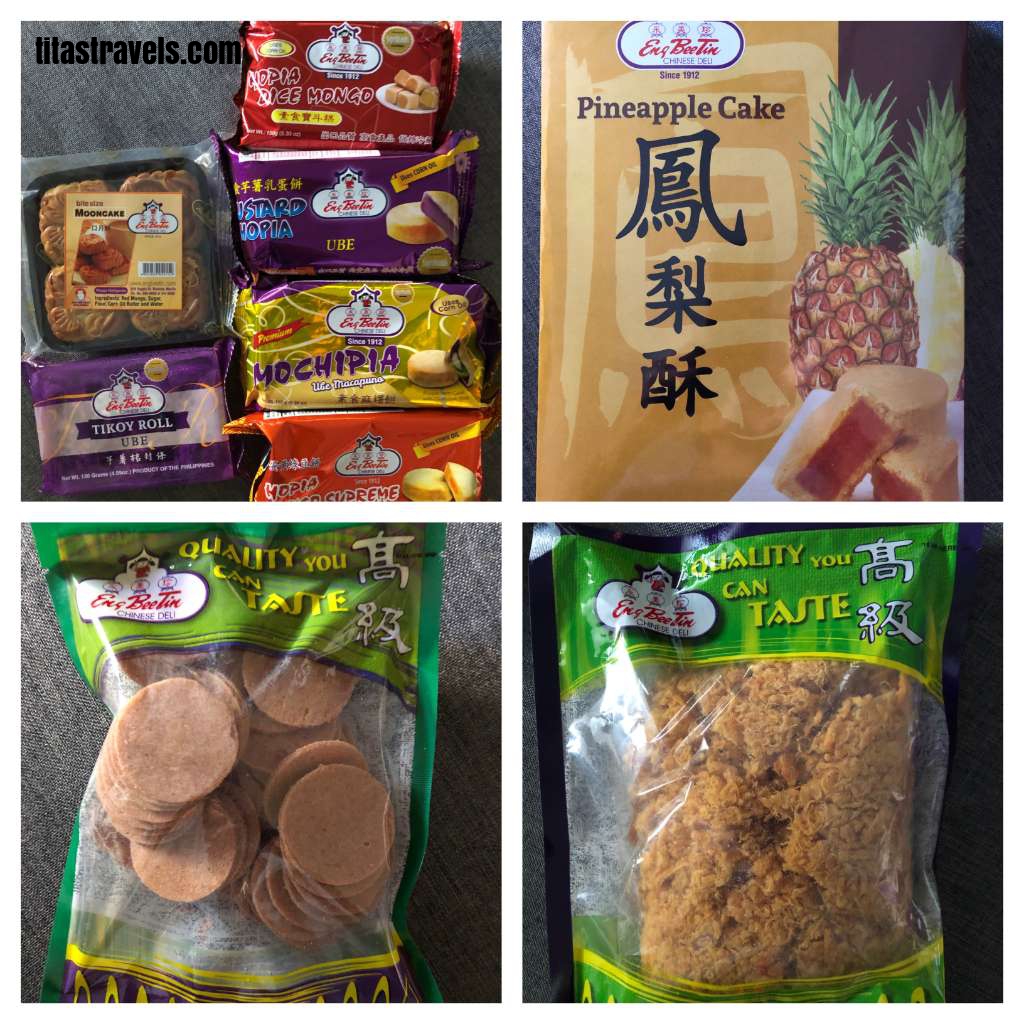

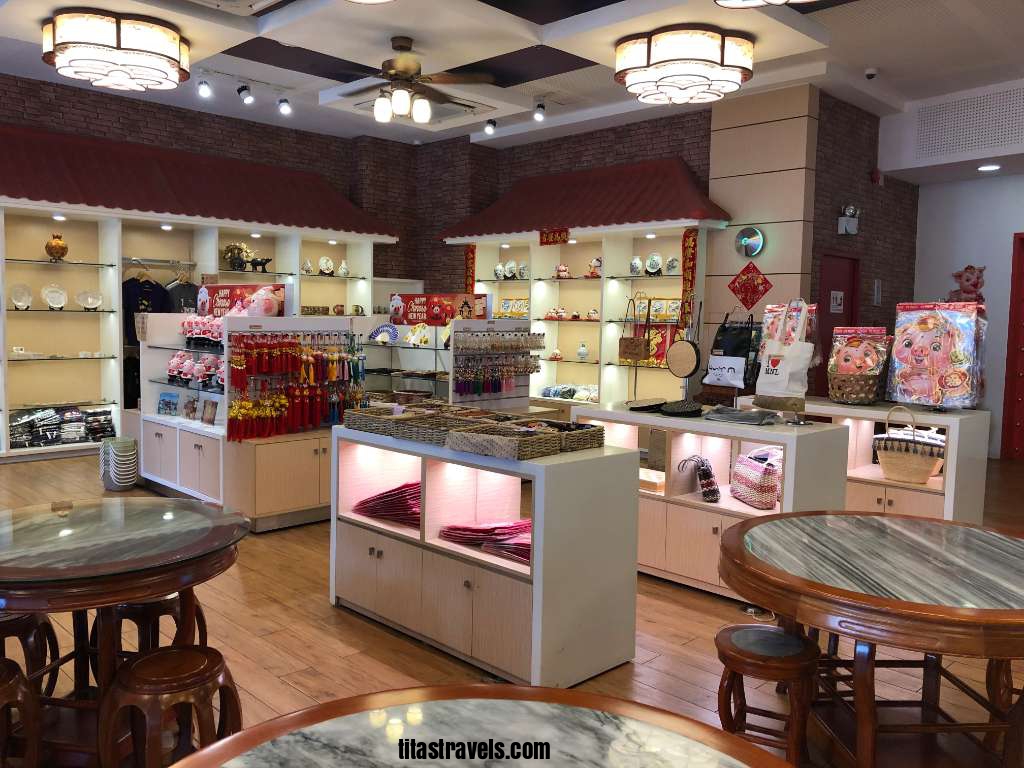 On this floor, you not only feast your eyes on Chinese charms and decorations but also on native bags, fans, etc. in an open-style souvenir-shop display. I bought a beautiful rattan bag and a couple of lucky charms. Of course, this floor is also where you can dine and enjoy Chinese cuisine.
On this floor, you not only feast your eyes on Chinese charms and decorations but also on native bags, fans, etc. in an open-style souvenir-shop display. I bought a beautiful rattan bag and a couple of lucky charms. Of course, this floor is also where you can dine and enjoy Chinese cuisine.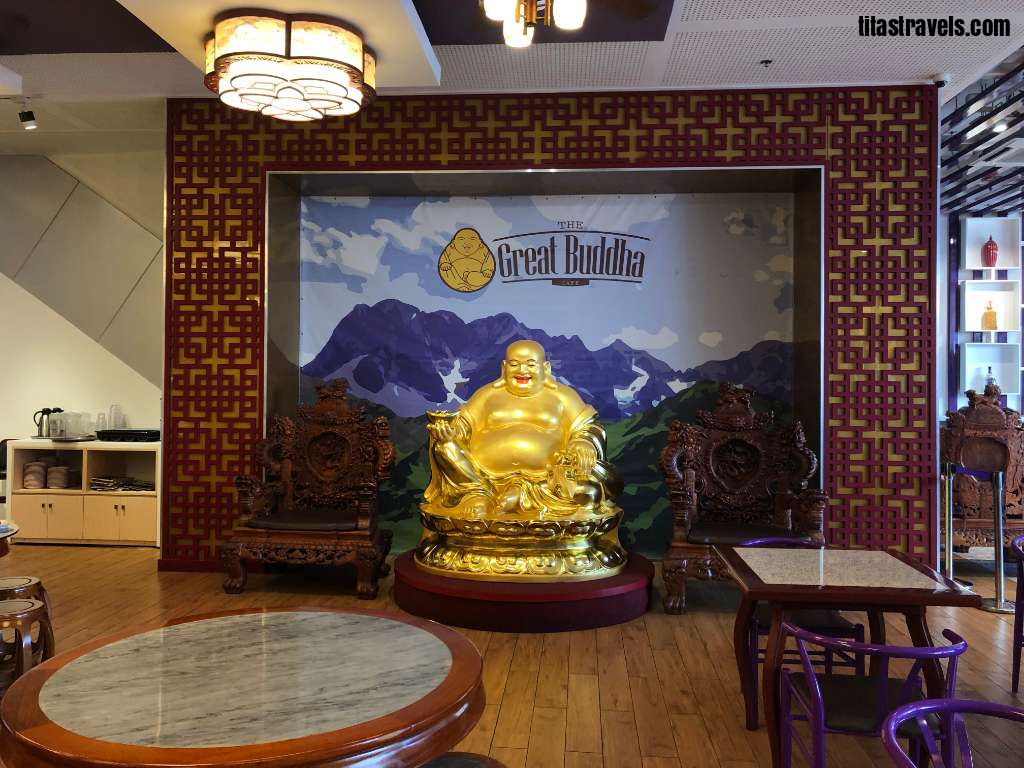 The café looks so spacious and what will attract your attention on one side of the dining area is the huge golden buddha statue with two intricately carved wooden chairs on each side. Guests may take turns posing with the buddha and/or seated on the chair/s. This is indeed a welcome feeling of space compared to other restaurants in the area.There is also free wi-fi.
The café looks so spacious and what will attract your attention on one side of the dining area is the huge golden buddha statue with two intricately carved wooden chairs on each side. Guests may take turns posing with the buddha and/or seated on the chair/s. This is indeed a welcome feeling of space compared to other restaurants in the area.There is also free wi-fi.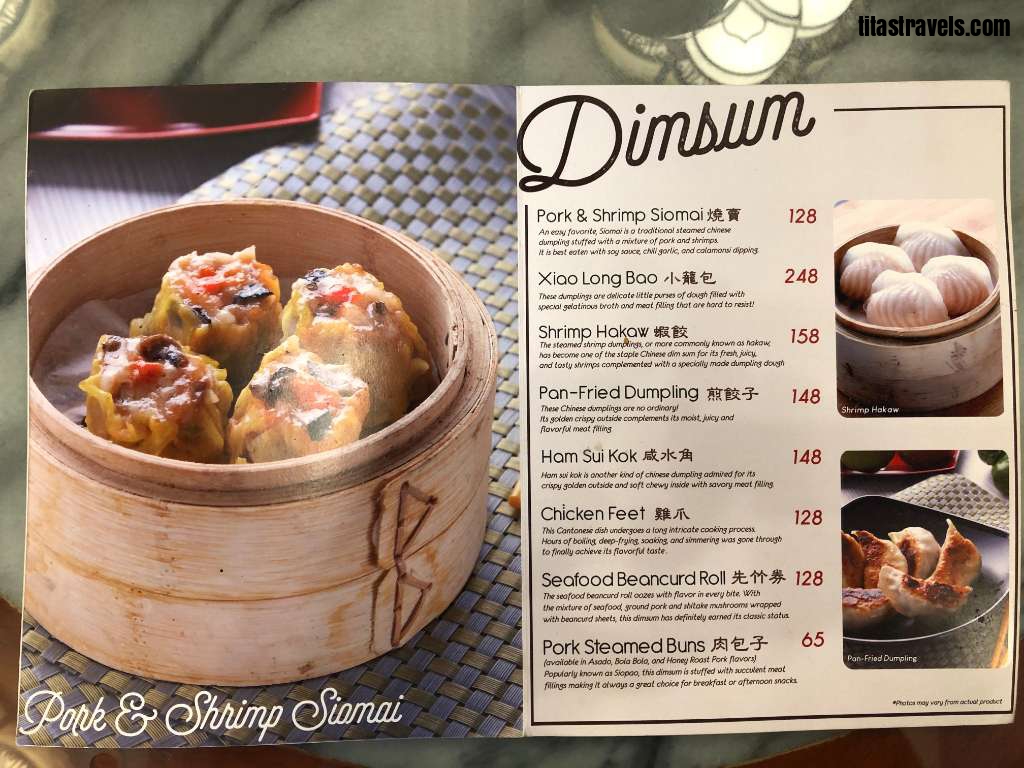 Dimsum10
Dimsum10 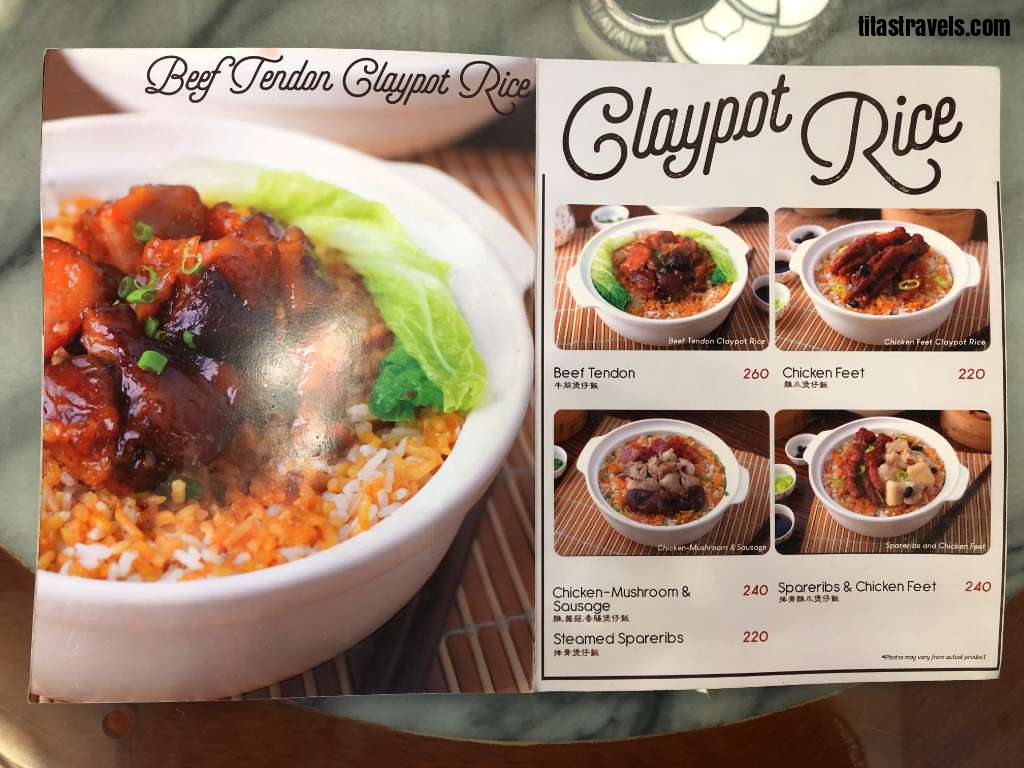 Claypot Rice
Claypot Rice 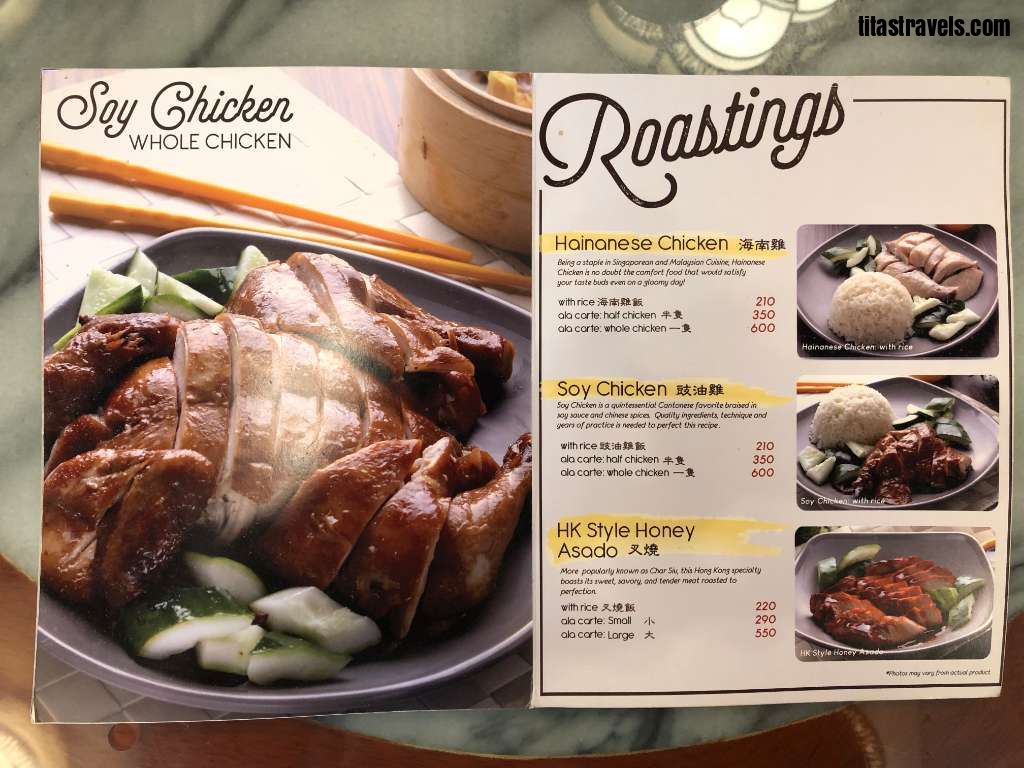 Roastings
Roastings 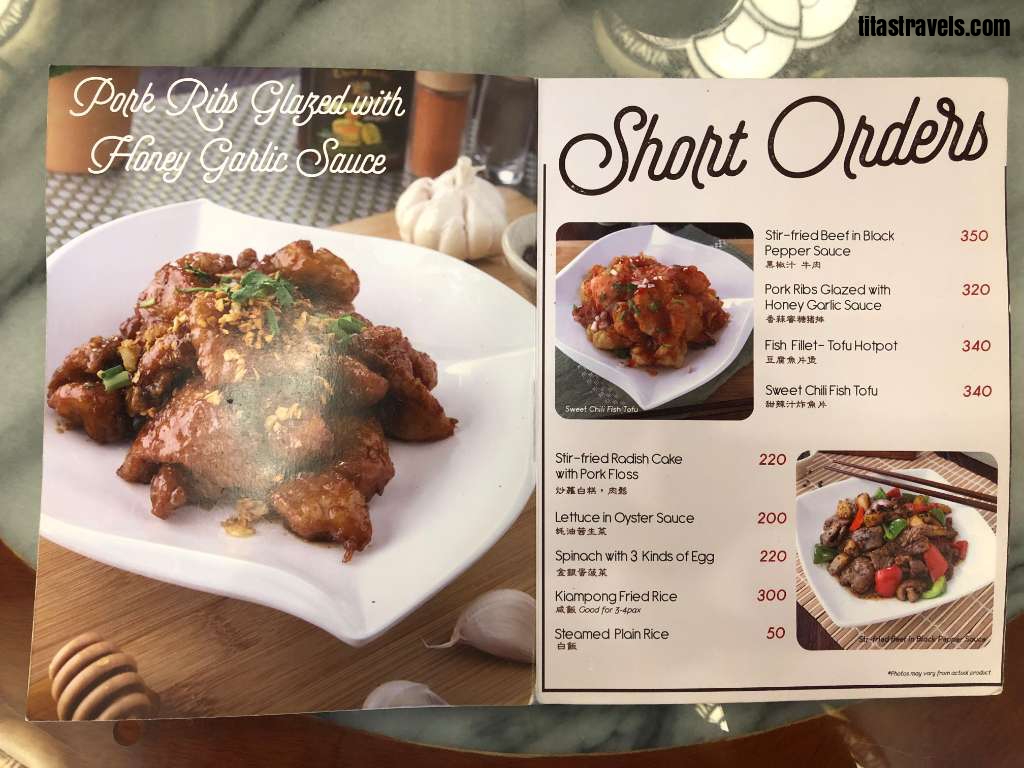 Short Orders
Short Orders 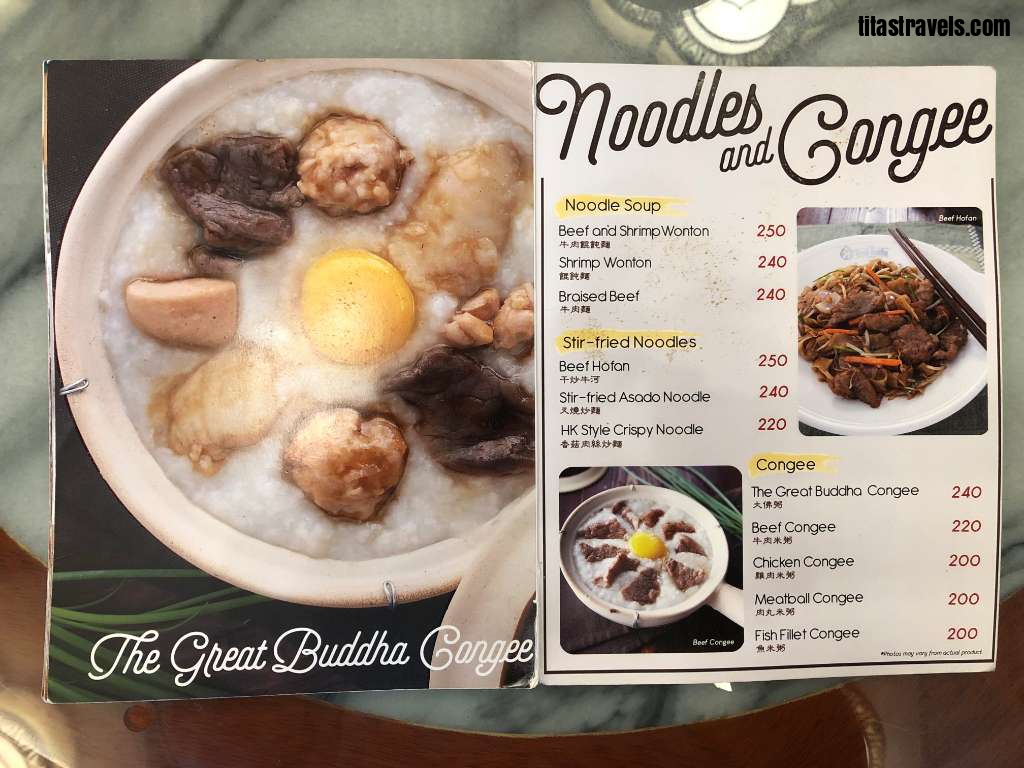 Noodles and Congee11
Noodles and Congee11 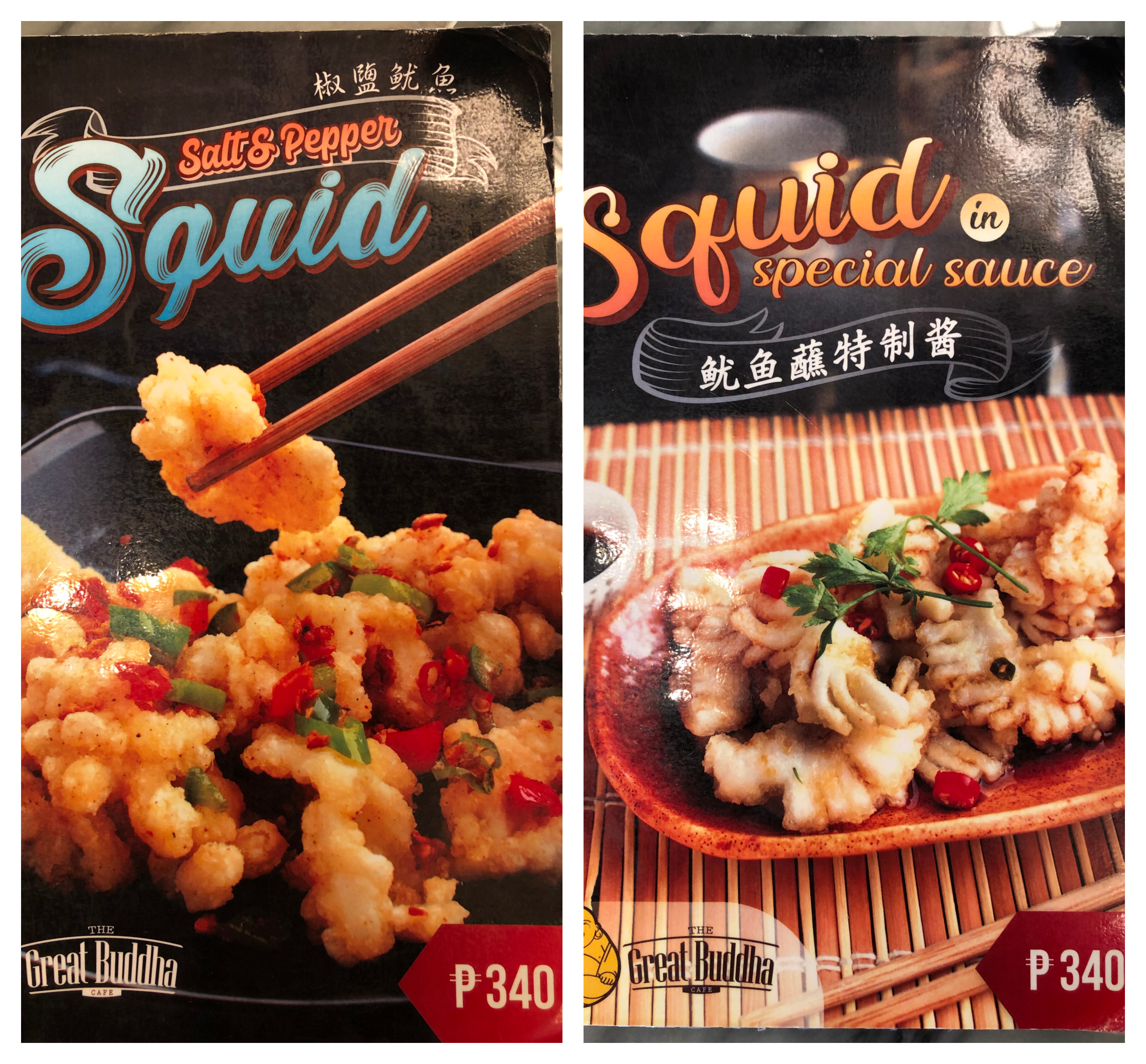 You can also order squids dishes
You can also order squids dishes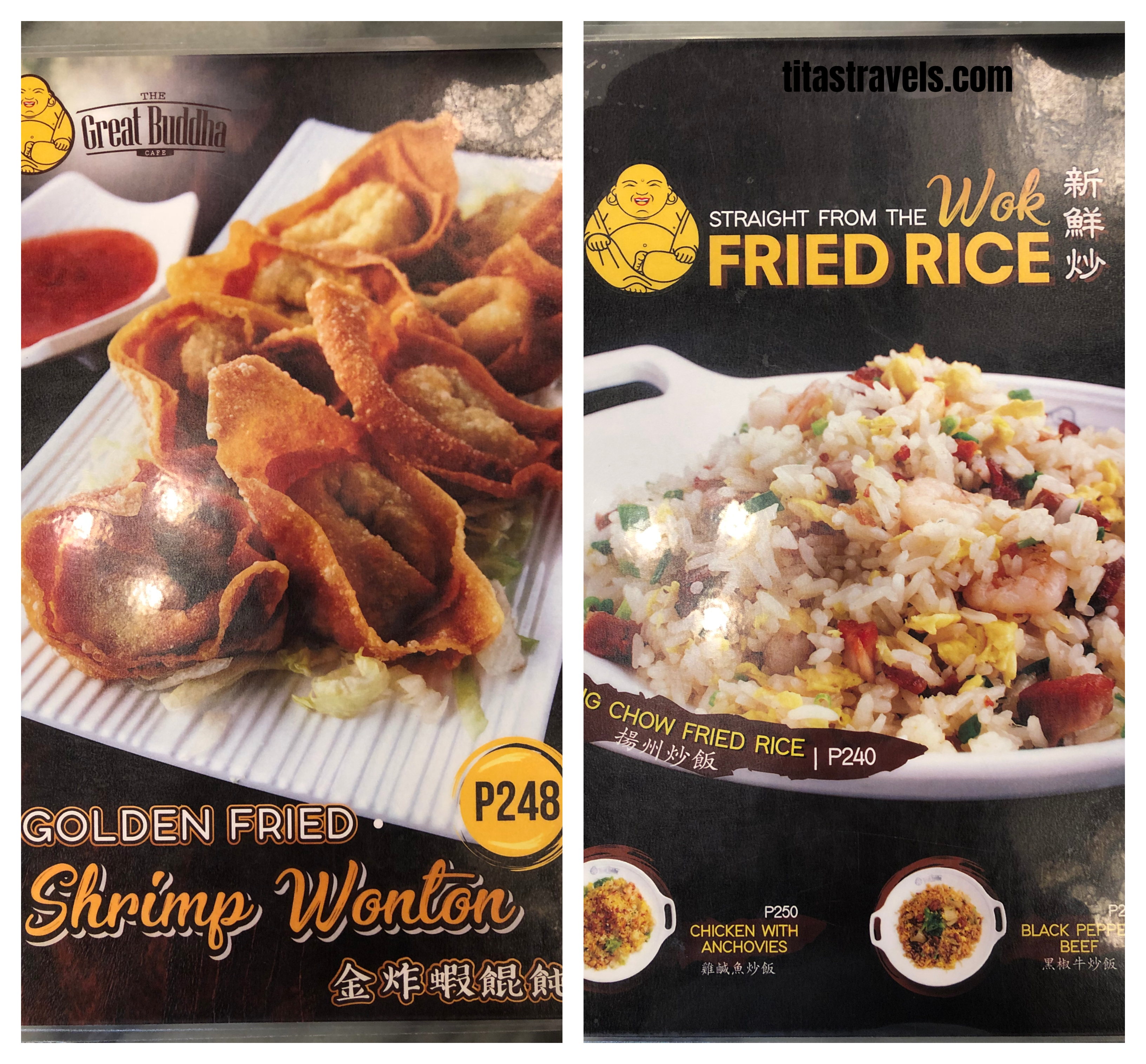 Fried Shrimp Wonton, Yang Chow Fried Rice, Chicken with Anchovies and Black Pepper Beef are also available
Fried Shrimp Wonton, Yang Chow Fried Rice, Chicken with Anchovies and Black Pepper Beef are also available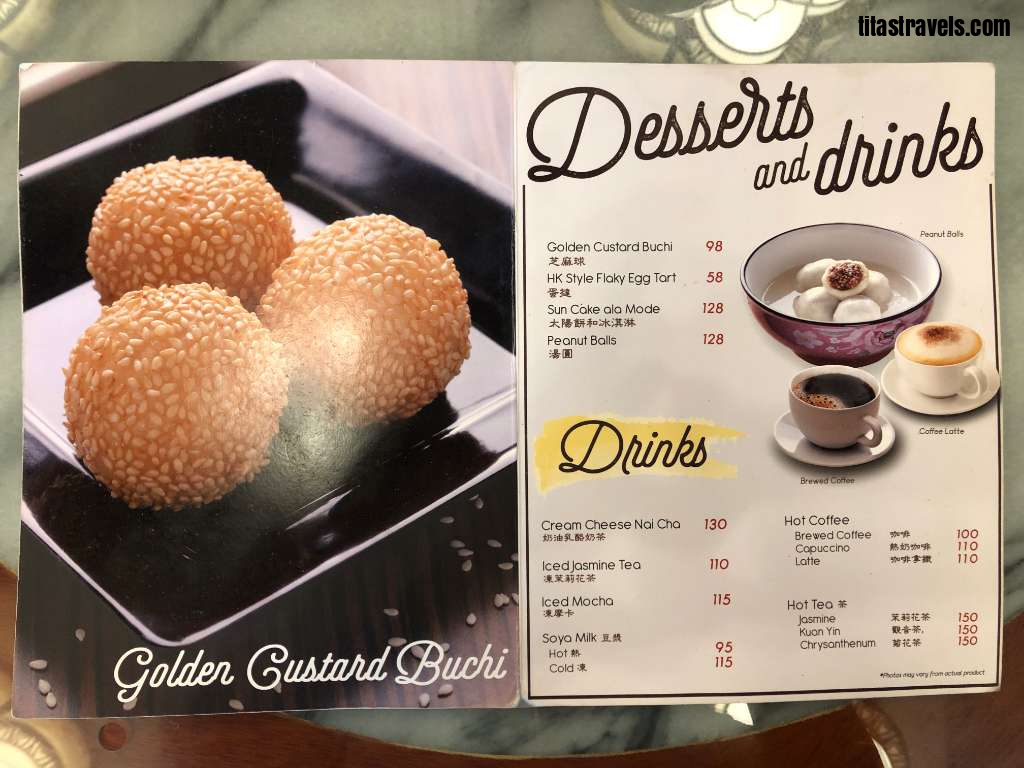 Desserts and Drinks
Desserts and Drinks 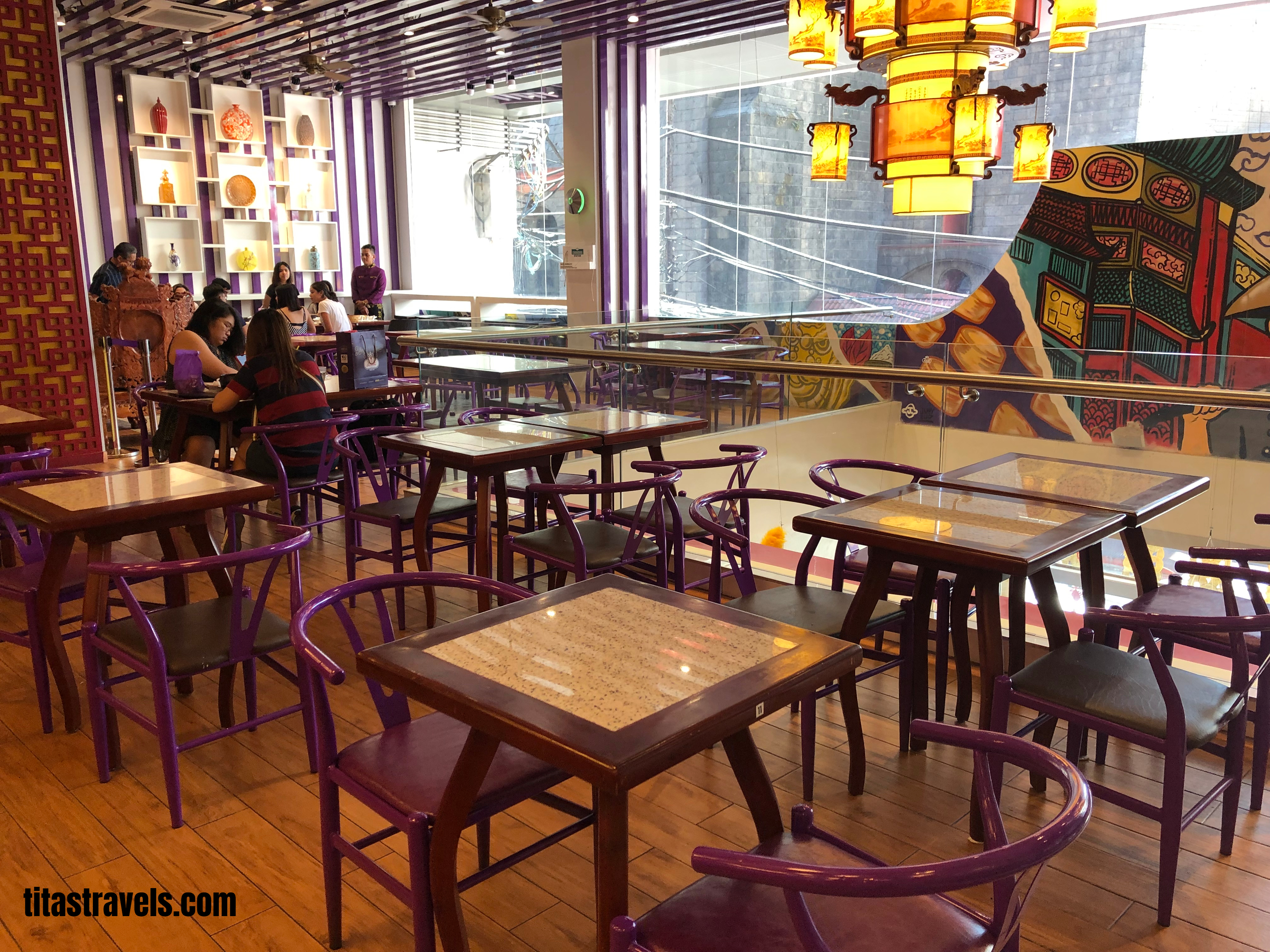 I had lunch here with four other family members. The air-conditioning temperature was just right even when the dining area was full.
I had lunch here with four other family members. The air-conditioning temperature was just right even when the dining area was full.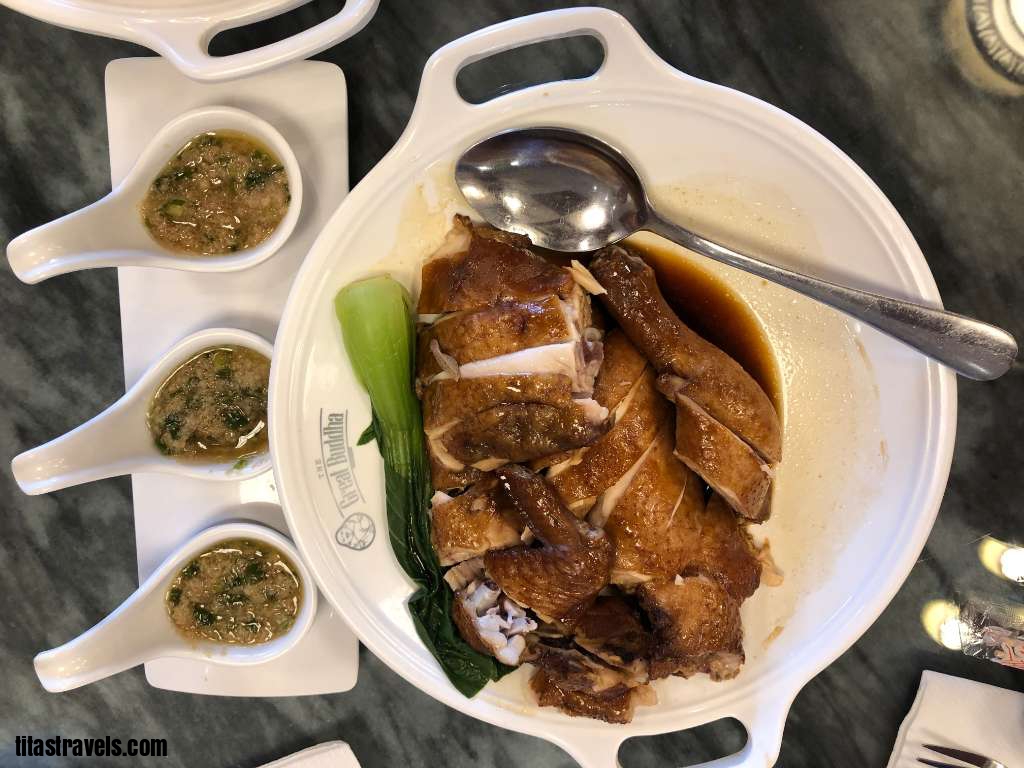 The Hainanese Chicken (PHP600 for a whole chicken) was served hot. The chicken was so tender and flavorful and I really enjoyed it along with the Ginger Sauce, made of ginger, garlic, sesame oil and chicken broth. I like the idea that the sauce was portioned per person so we do not have to take turns getting from one large container.
The Hainanese Chicken (PHP600 for a whole chicken) was served hot. The chicken was so tender and flavorful and I really enjoyed it along with the Ginger Sauce, made of ginger, garlic, sesame oil and chicken broth. I like the idea that the sauce was portioned per person so we do not have to take turns getting from one large container.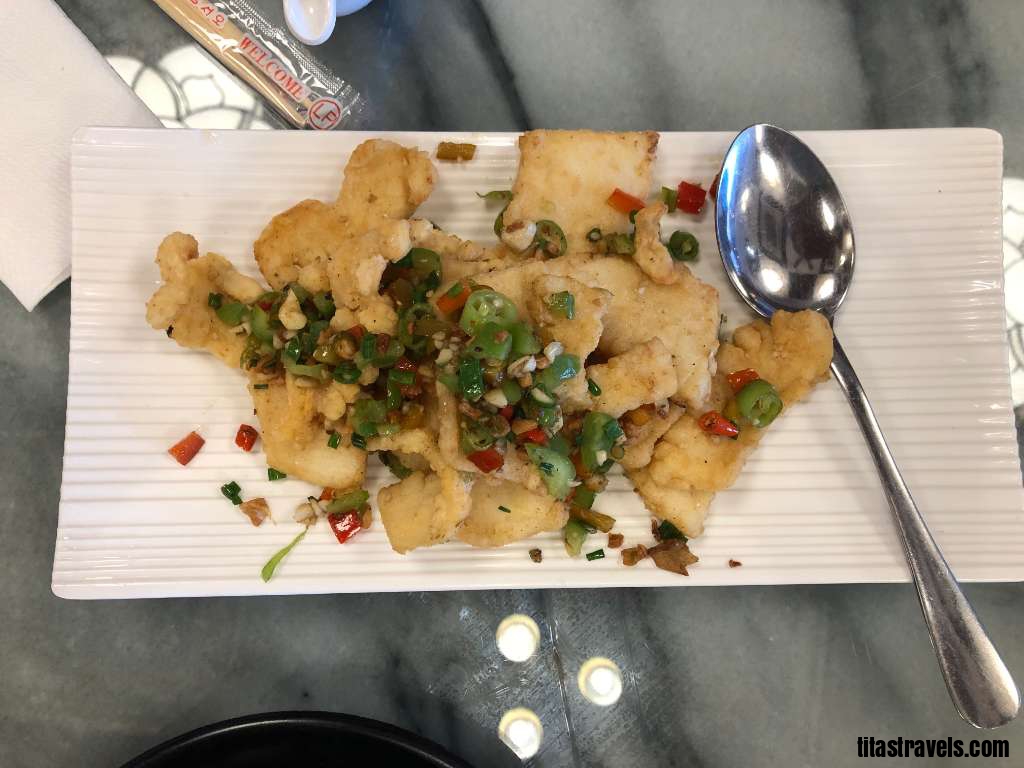 The Salt and Pepper Fried Squid (PHP340) was fried and seasoned just right. The chopped red and green pepper not only improved its appearance, but its overall taste as well.
The Salt and Pepper Fried Squid (PHP340) was fried and seasoned just right. The chopped red and green pepper not only improved its appearance, but its overall taste as well.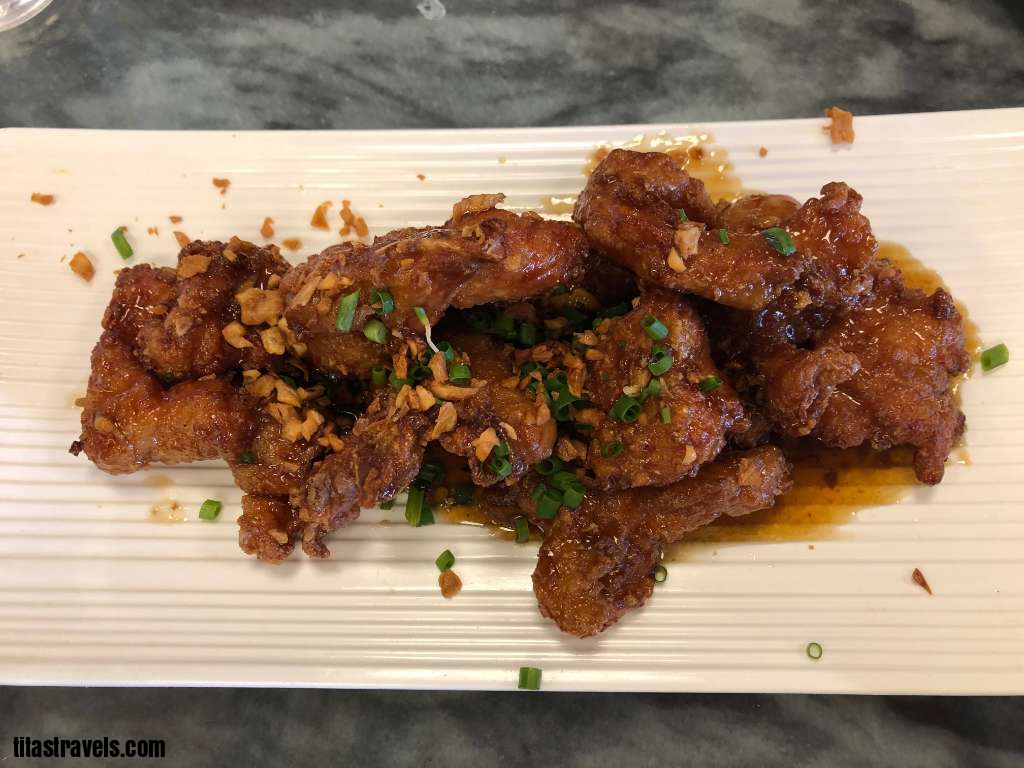 The Pork Ribs Glazed with Honey Garlic Sauce (PHP320) was delightfully savory. The pork was very tender and crispy, and the flavorful honey-garlic glaze was so magical to my taste buds.
The Pork Ribs Glazed with Honey Garlic Sauce (PHP320) was delightfully savory. The pork was very tender and crispy, and the flavorful honey-garlic glaze was so magical to my taste buds.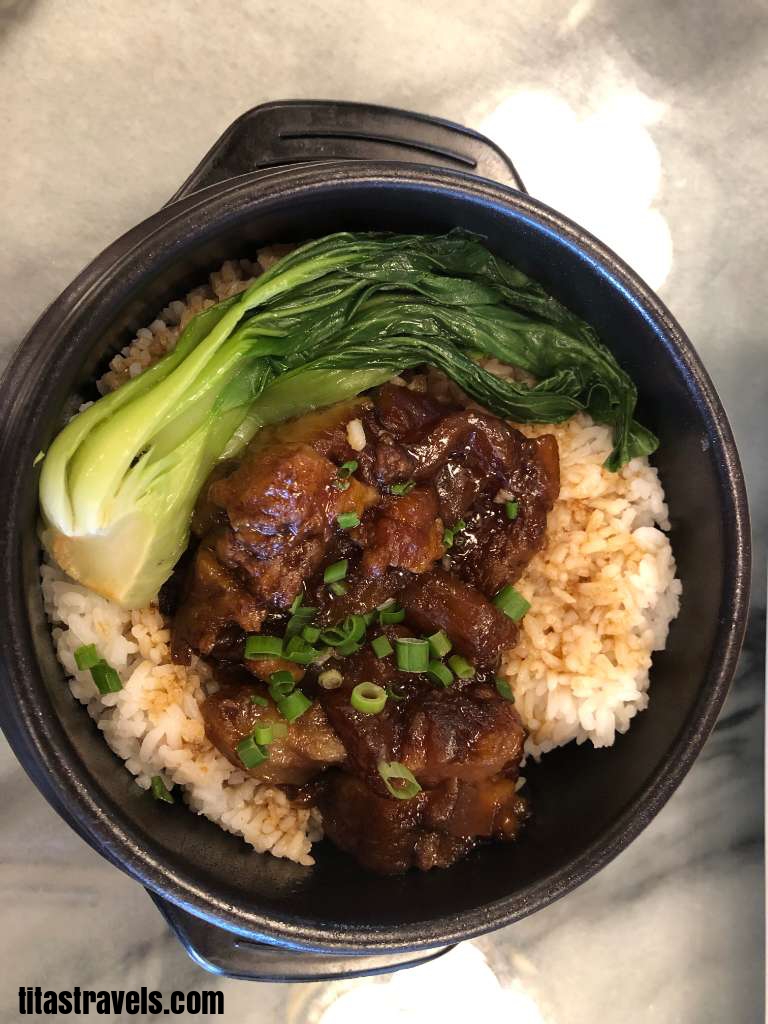 The Beef Tendon Claypot Rice (PHP260) was good for one generous serving. The tendon was very tender and the sauce tasted just right with the beef tendon and plain rice.
The Beef Tendon Claypot Rice (PHP260) was good for one generous serving. The tendon was very tender and the sauce tasted just right with the beef tendon and plain rice.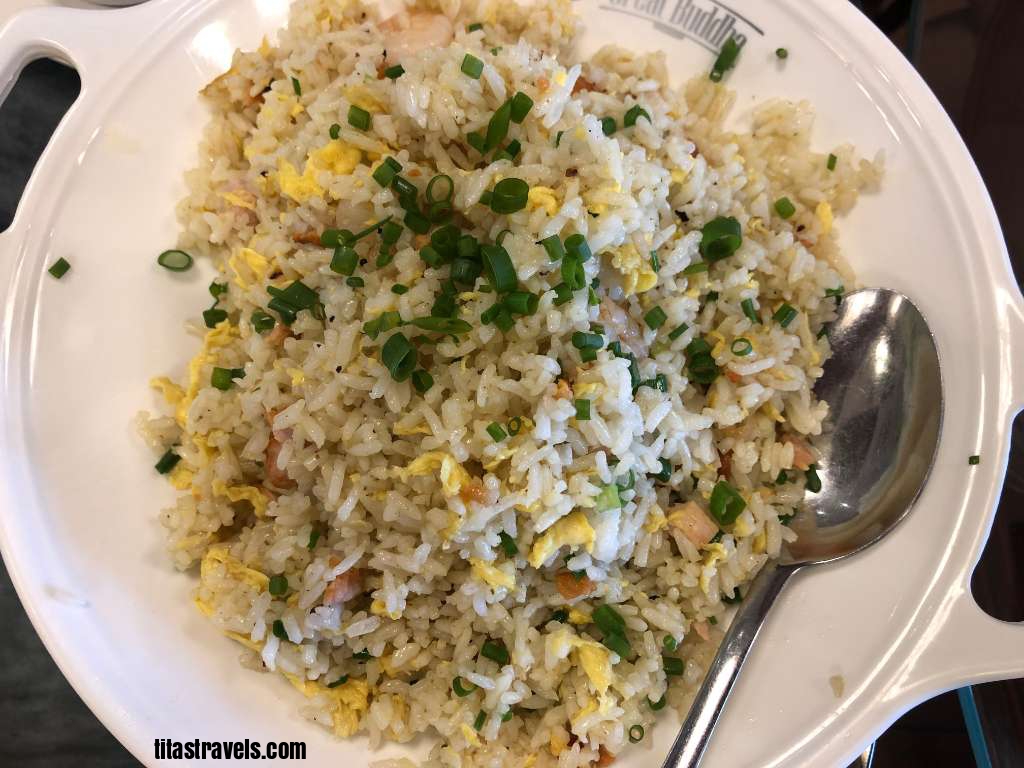 The Yang Chow Fried Rice (PHP240) was served hot and the rice was pleasantly mixed with shrimps, meat, bits of scrambled egg and other colorful and flavorful ingredients. This was a welcome accompaniment for the main dishes we ordered.
The Yang Chow Fried Rice (PHP240) was served hot and the rice was pleasantly mixed with shrimps, meat, bits of scrambled egg and other colorful and flavorful ingredients. This was a welcome accompaniment for the main dishes we ordered.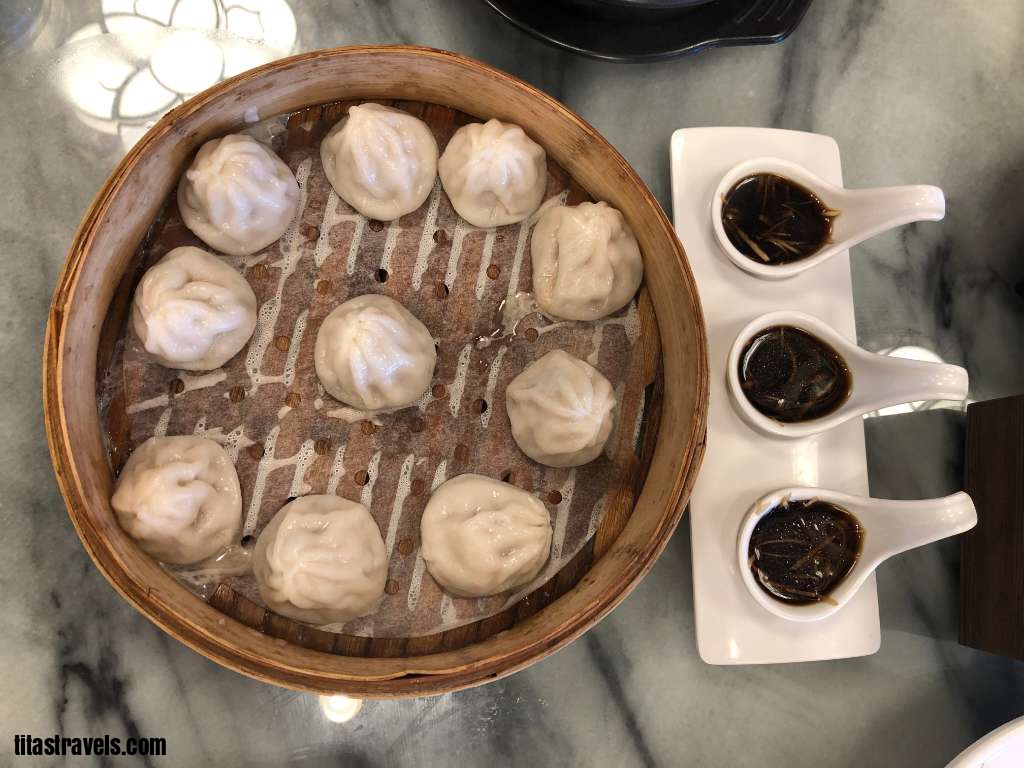 TheXiao Long Bao (XLB for short, PHP248 for 10 pieces) was served hot in a bamboo steamer basket. The skin is just right (not too thick, not too thin) and did not easily tear when lifted onto the Chinese soup spoon. The soup inside the dimsum10 was tasty and the meat filling was tender. We appreciated the portioned dipping sauce made of black vinegar and fresh ginger slivers.
TheXiao Long Bao (XLB for short, PHP248 for 10 pieces) was served hot in a bamboo steamer basket. The skin is just right (not too thick, not too thin) and did not easily tear when lifted onto the Chinese soup spoon. The soup inside the dimsum10 was tasty and the meat filling was tender. We appreciated the portioned dipping sauce made of black vinegar and fresh ginger slivers.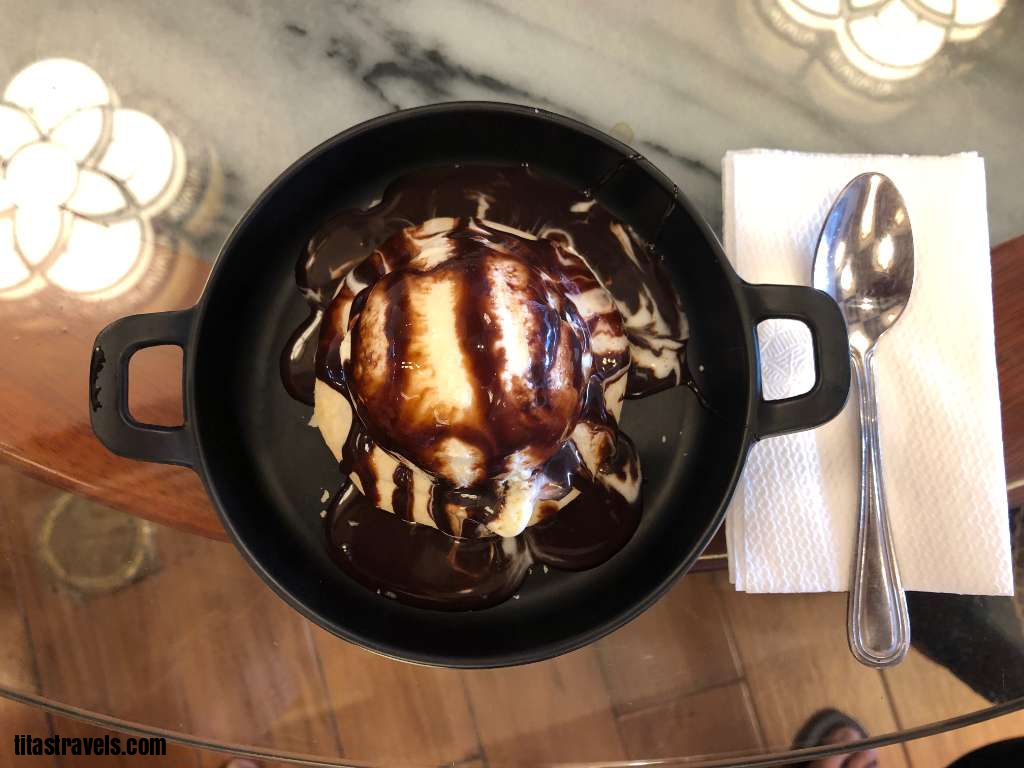 I ordered the HK-Style Flaky Egg Tart (PHP58) but was told it was already sold out. Next time, I will come earlier and try it. Anyway, I settled for Sun Cake16 ala Mode. It was served with chocolate ice cream on top with chocolate syrup. I found it too sweet, so next time, I will request them not to place the chocolate syrup.
I ordered the HK-Style Flaky Egg Tart (PHP58) but was told it was already sold out. Next time, I will come earlier and try it. Anyway, I settled for Sun Cake16 ala Mode. It was served with chocolate ice cream on top with chocolate syrup. I found it too sweet, so next time, I will request them not to place the chocolate syrup.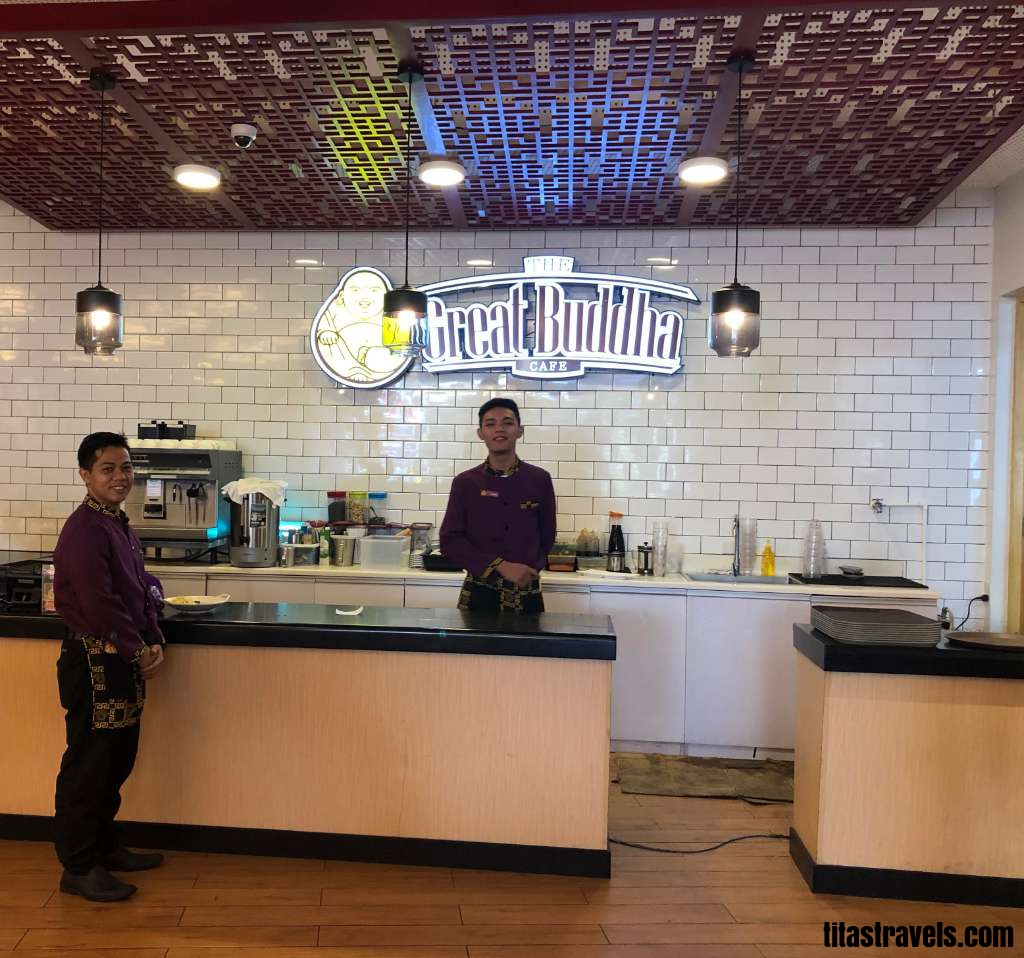 The dining room employees were all very accommodating and efficient. Dishes were served at the right temperature and pace.
The dining room employees were all very accommodating and efficient. Dishes were served at the right temperature and pace.

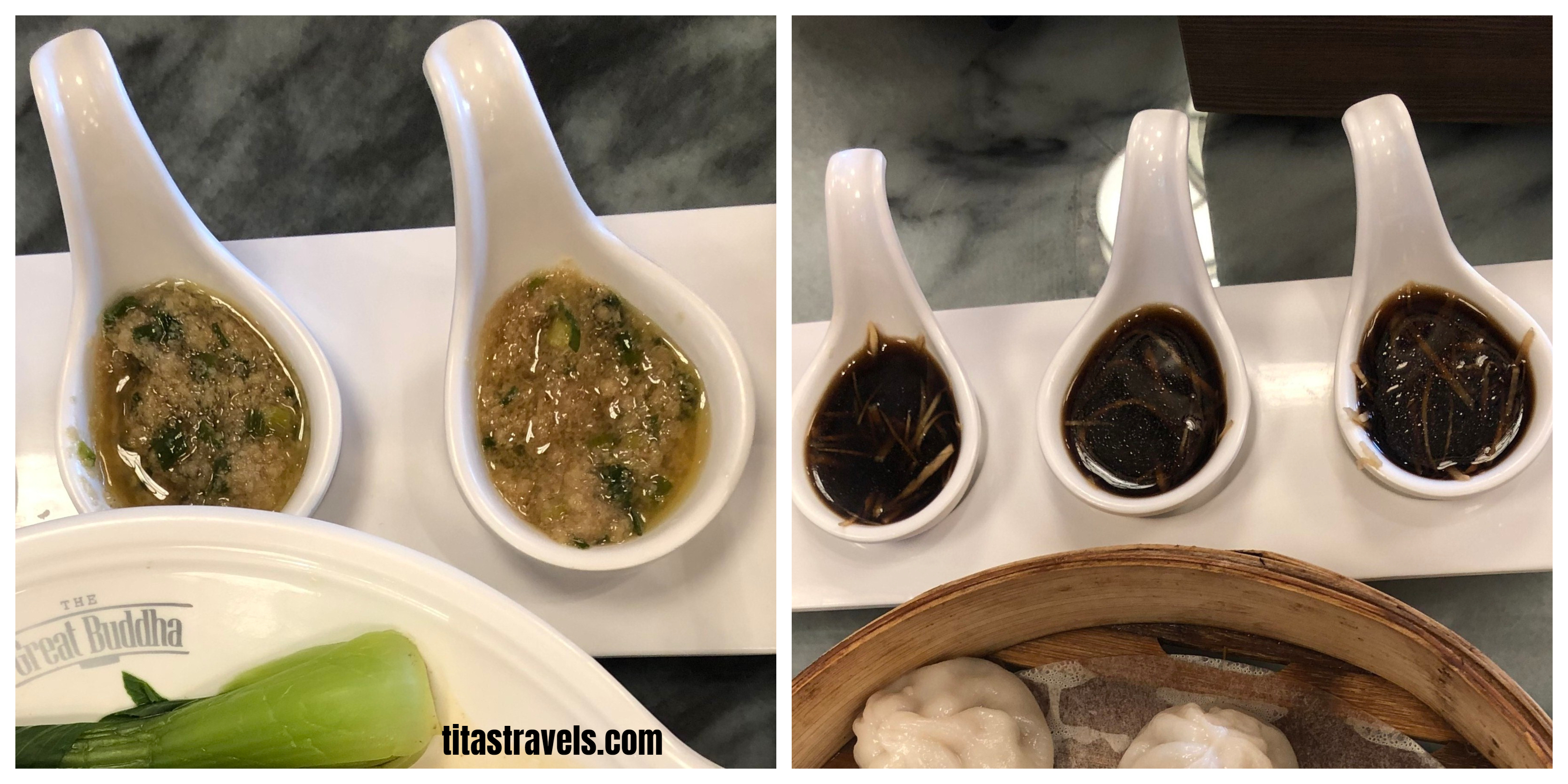 Accompanying sauces/dips were given to each person which we really appreciated. Oh, you can also ask for more, just in case you are partial to them, like the ginger sauce for the Hainanese Chicken.
Accompanying sauces/dips were given to each person which we really appreciated. Oh, you can also ask for more, just in case you are partial to them, like the ginger sauce for the Hainanese Chicken.
